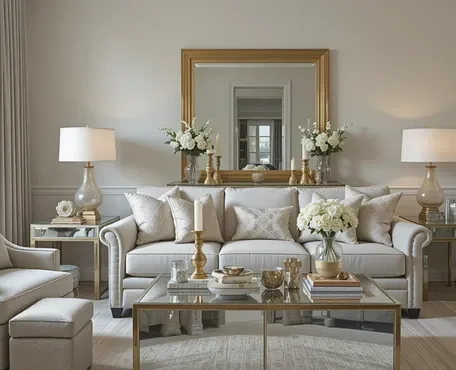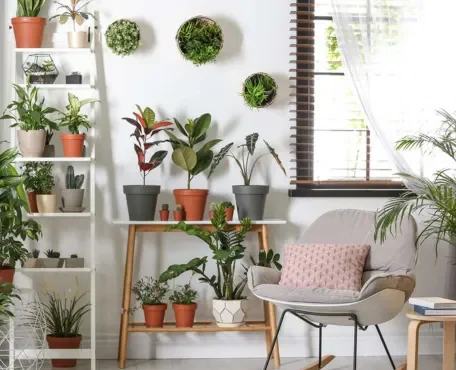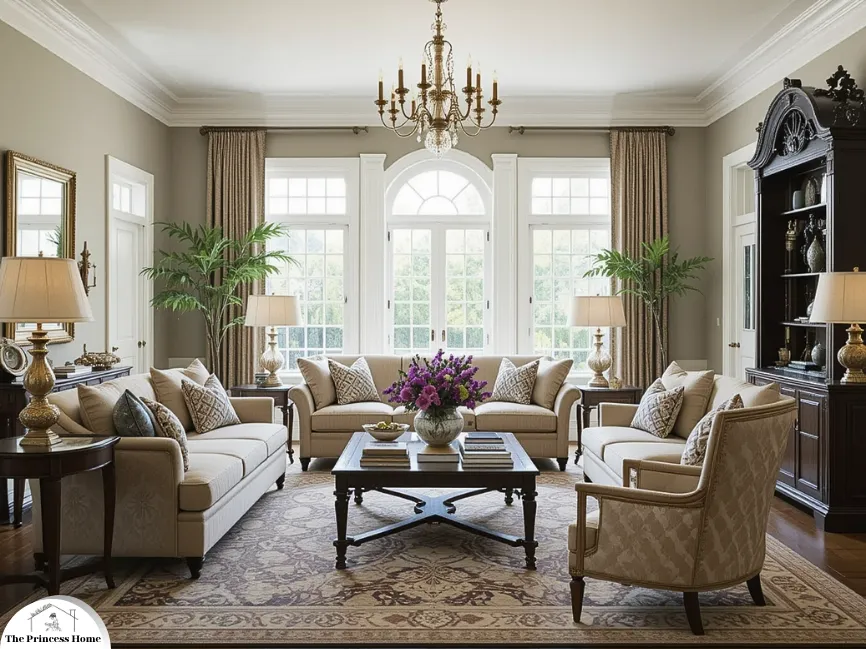
Design Styles for Your Home: Choose Decor to Suit Your Taste
Designing your home is a deeply personal and exciting endeavor. It’s an opportunity to express your personality, preferences, and lifestyle through the aesthetics of your living space. With an abundance of design styles to choose from, finding the perfect fit for your home can be both inspiring and overwhelming. This article aims to guide you through the process of selecting a design style that resonates with your taste and offers practical tips on incorporating it into your home decor.
Here’s a guide to help you explore different design styles and find one that speaks to your taste and lifestyle.
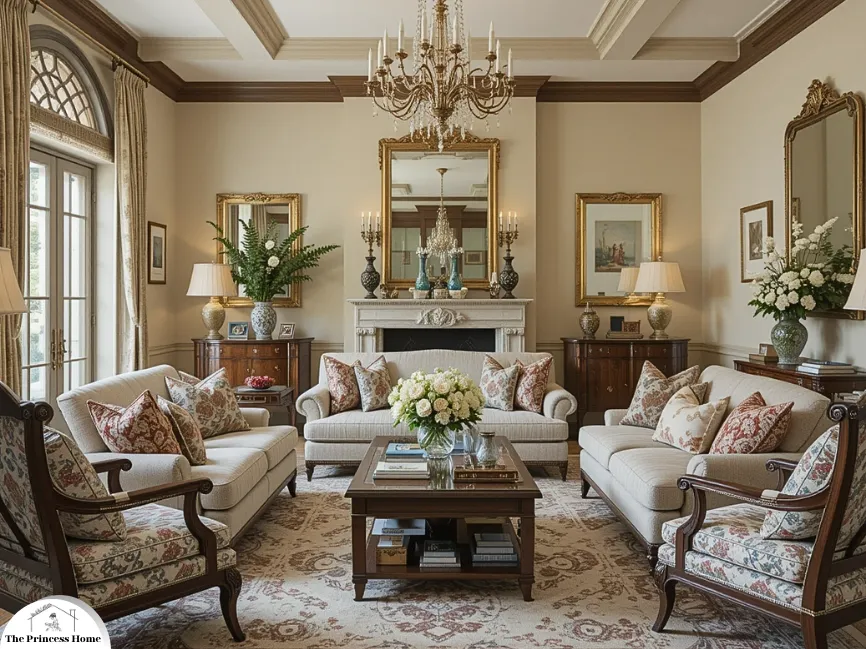
*Choose Decor to Suit Your Taste*
When it comes to home decor, the design style you choose plays a pivotal role in setting the tone and atmosphere of your living space. From cozy rustic vibes to sleek modernism, the right style can make your home feel truly personal and inviting.
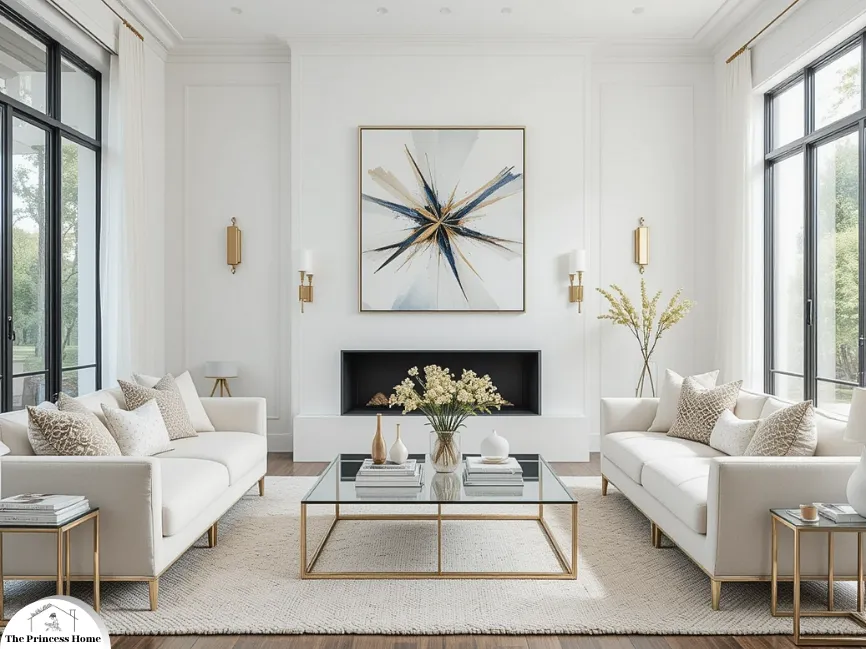
1. Modern Elegance
Modern elegance is all about simplicity and clean lines. It embraces minimalism, focusing on functional, well-designed pieces that make a statement without overwhelming the space. This style often incorporates neutral tones, metallic finishes, and glass elements to create an airy and polished look. To bring modern elegance to life in your home, think of crisp white walls paired with soft, contemporary furniture and accent pieces like glass coffee tables and abstract artwork. To enhance the modern elegance in your home, consider these ideas:
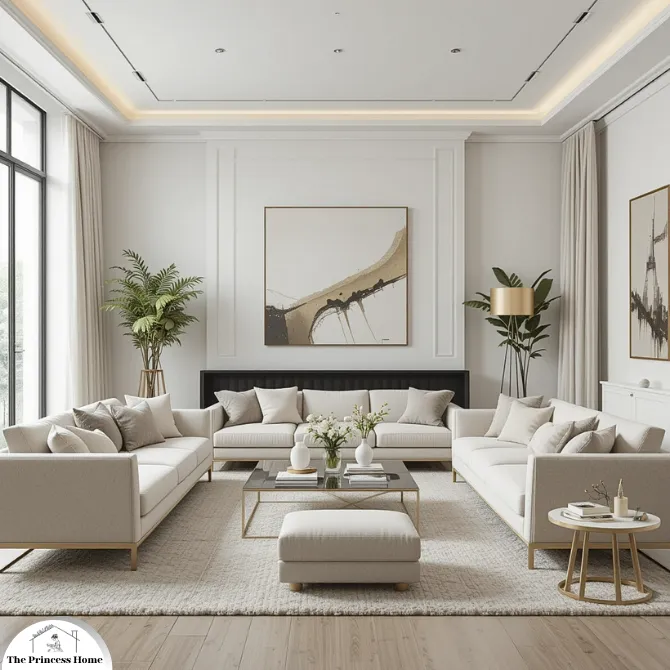
Color & Minimalistic Furniture
Stick to shades of white, gray, beige, and soft pastels for a serene and cohesive atmosphere. Adding pops of metallics like gold, silver, or chrome can elevate the space without overcrowding it. Choose sleek, functional pieces with simple silhouettes. Opt for low-profile sofas, streamlined chairs, and minimalist coffee tables. Furniture with clean lines and subtle details creates an effortlessly chic look.

Lighting & Natural Materials
Invest in bold, sculptural light fixtures like pendant lights or chandeliers that serve as art pieces. Glass, brushed metal, and geometric shapes work well for this style. Incorporate natural textures like wood, stone, and marble for a refined yet organic feel. A marble countertop or wooden accents can add warmth and contrast to the otherwise neutral palette.
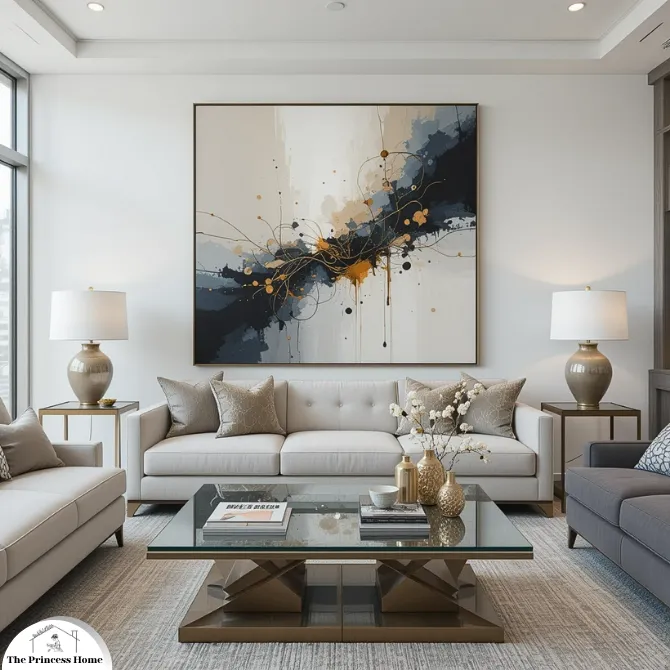
Abstract Art& Metallic Accents
Choose abstract or minimalist artwork that adds personality without clashing with the surroundings. Large-scale pieces can act as focal points in open spaces. Integrate glass surfaces, like a glass coffee table or shelves, and metallic elements in decor pieces such as mirrors, vases, or lamps to reflect light and add sophistication.
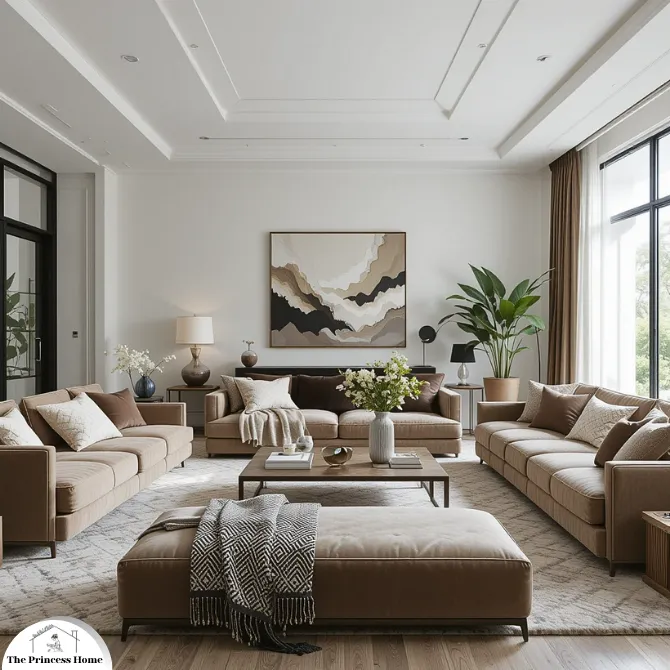
Open Space &Luxurious Textiles
Keep the floor plan open and airy by opting for fewer, larger pieces instead of many small items. A spacious living room with unobstructed sightlines enhances the feeling of modern elegance. Use high-quality fabrics for upholstery, such as velvet, linen, and leather. Soft, luxurious throws and pillows add comfort while maintaining the modern aesthetic.
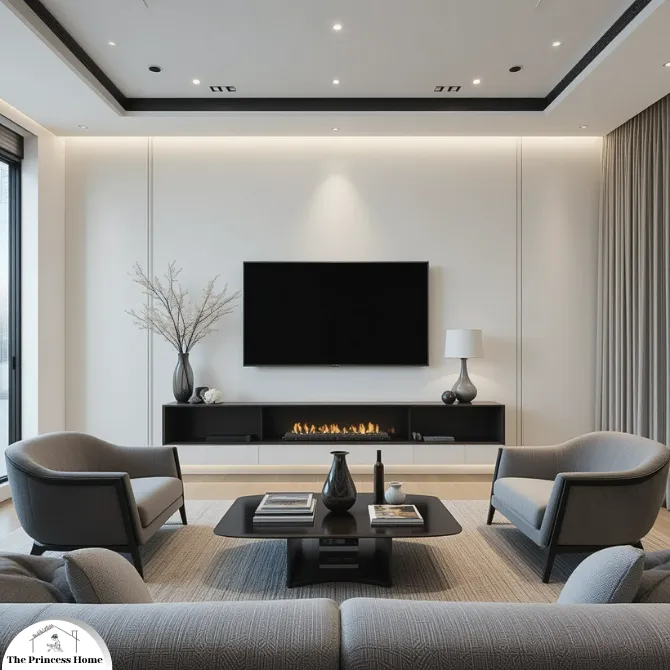
Minimalist Decor& Smart Technology
Keep decorative items to a minimum. When you do decorate, select a few key pieces, such as a stylish vase or a designer coffee table book, that contribute to the overall modern elegance without creating clutter. Embrace modern technology with sleek gadgets and integrated smart systems. A hidden sound system, smart lighting, and smart thermostats are subtle yet high-tech additions that align with this style. By focusing on these elements, you can create a sophisticated, serene, and effortlessly chic modern elegant home.
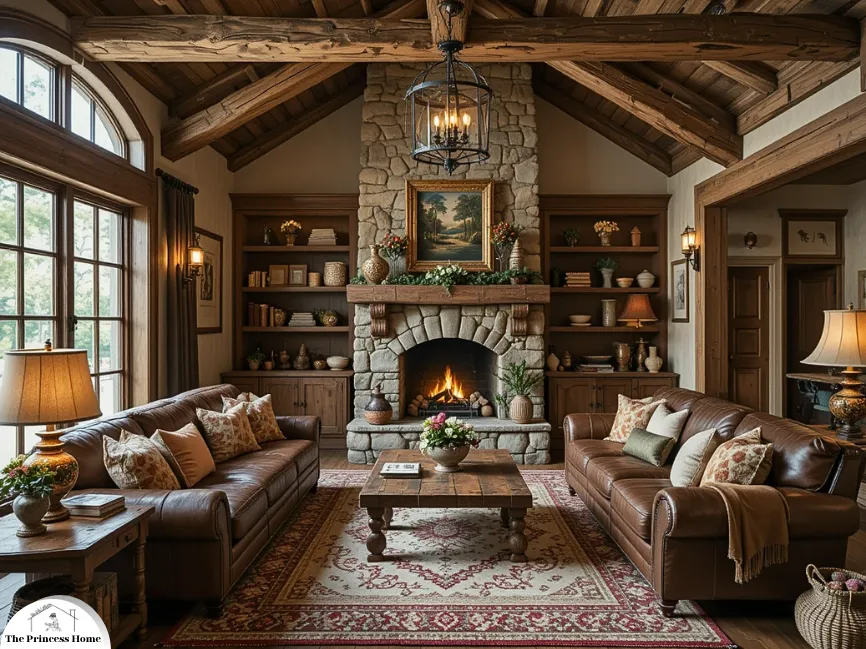
2. Rustic Charm
Rustic charm is a design style that celebrates the beauty of nature and the coziness of home. It incorporates raw materials like wood, stone, and leather, creating a warm, inviting space with an earthy feel. Think exposed beams, distressed wood furniture, and natural stone fireplaces. Color palettes lean toward earthy tones—like browns, greens, and deep reds—to evoke a sense of grounded comfort. Accessories like woven baskets, vintage lighting, and patterned throws are great ways to complete this look. To fully embrace rustic charm in your home, here are some additional ideas to bring the warm, earthy feel to life:
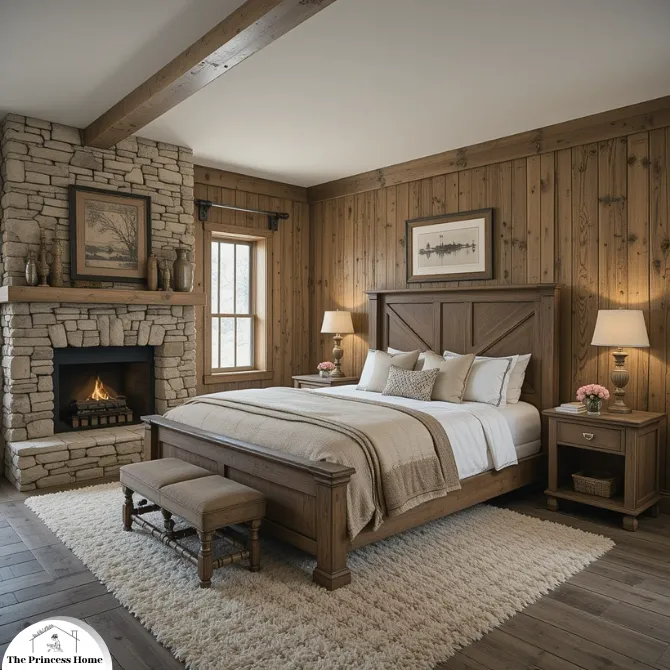
Wooden Accents& Stone
Incorporate reclaimed wood, barn doors, and wood paneling to give the space a lived-in, rustic look. Opt for furniture pieces with a weathered finish, such as a wooden farmhouse dining table or a rustic wooden headboard for the bed. Add natural stone elements like a stone fireplace, exposed stone walls, or stone flooring to introduce texture and create a grounded, earthy ambiance.
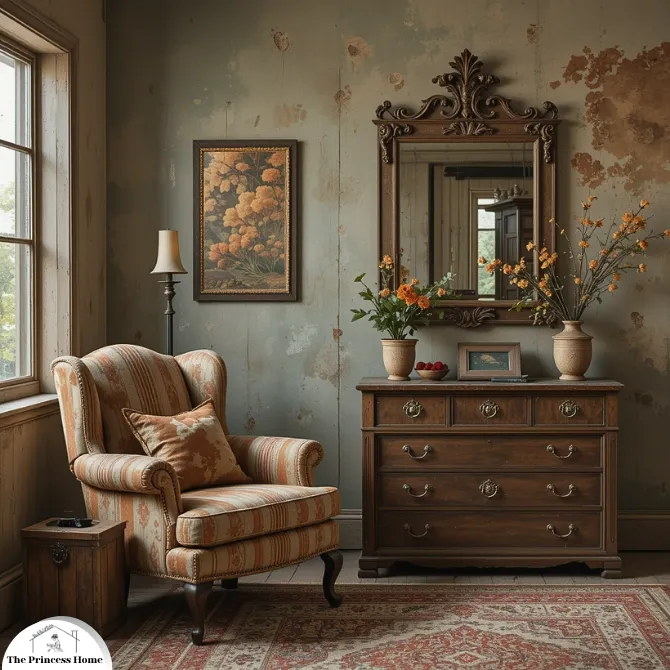
Earthy Color & Antique Finds:
Stick with a color palette inspired by nature—think soft neutrals, deep browns, and muted greens, combined with hints of warm reds or oranges. These shades evoke a cozy, welcoming atmosphere. Incorporate antique furniture pieces or vintage accessories to enhance the rustic charm. A weathered armchair, old-fashioned trunk, or a vintage mirror can add character and history to the space.
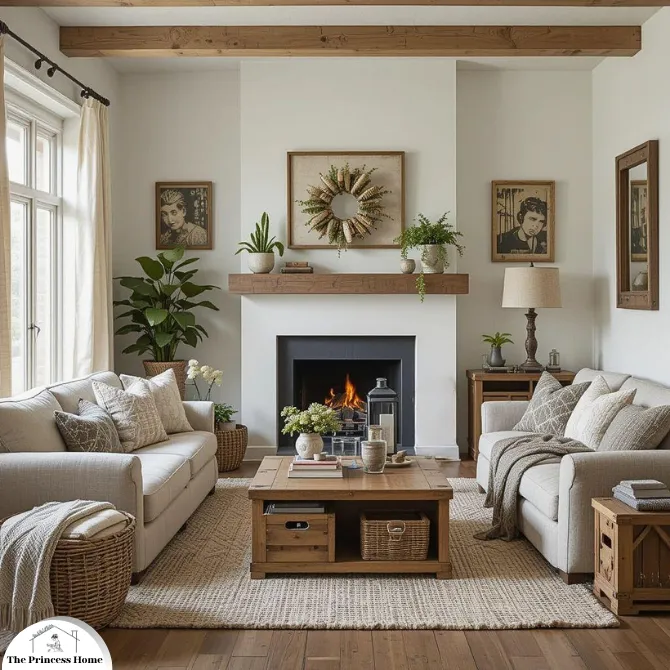
Natural Textiles & Woven Baskets
Use linen, cotton, wool, and burlap for curtains, cushions, and throws to introduce tactile textures that complement the rustic aesthetic. Cozy knitted blankets, plaid patterns, and wool rugs can further enhance the cozy, inviting vibe. Woven baskets and wooden crates make excellent storage solutions while adding rustic charm to any room. They can be used for everything from holding blankets and pillows to storing firewood or magazines.
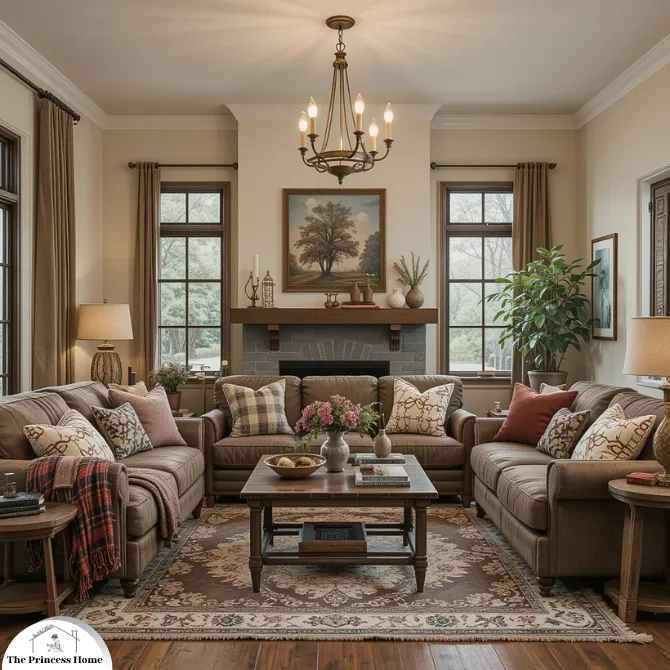
Antique Lighting& Pillows
Embrace vintage or industrial-style lighting, such as pendant lights with exposed bulbs or wrought-iron chandeliers, to add warmth and a touch of rustic elegance to the space. Layer comfortable throws and pillows in rich textures and earthy patterns like plaids, stripes, and florals. These elements add warmth and comfort, making the space feel even more inviting.
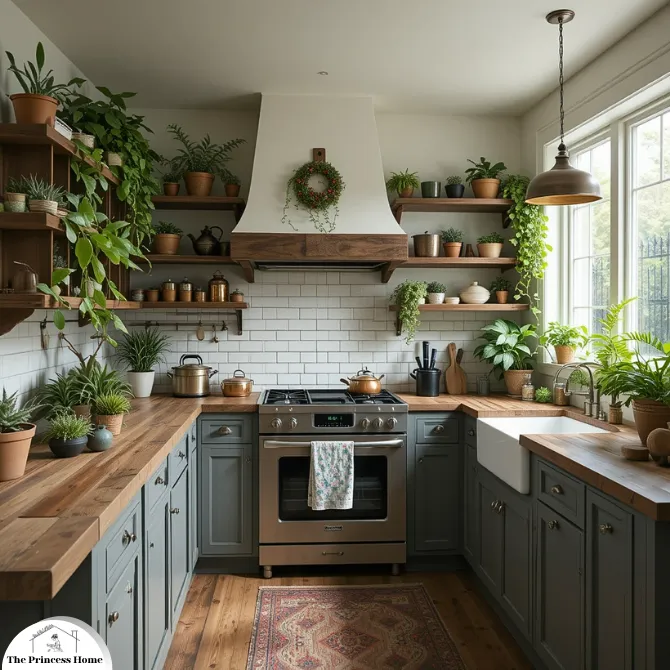
Indoor Plants & Rustic Kitchen
Bring the outdoors in by placing a variety of plants throughout the home. Succulents, ferns, and ivy thrive in rustic environments, adding greenery and life to the design. For the kitchen, consider open shelving, copper pots, and cast-iron skillets. Wooden countertops or butcher block surfaces can add warmth and rustic appeal, while vintage kitchenware brings character to the space.
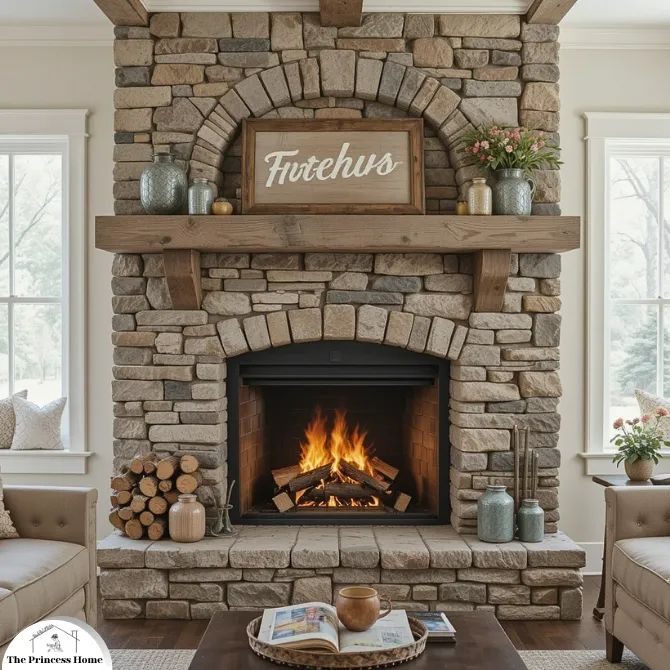
Firewood &Farmhouse Details
Create a cozy focal point in the living room or den with a stone or brick fireplace. A stacked pile of firewood adds a rustic touch and promotes the sense of comfort and warmth associated with this style. Incorporate farmhouse-inspired accents, such as galvanized metal signage, mason jar vases, and distressed furniture pieces, to bring a touch of rural charm to your space. By blending these elements, you can create a space that feels timeless, cozy, and perfectly aligned with the rustic charm aesthetic.
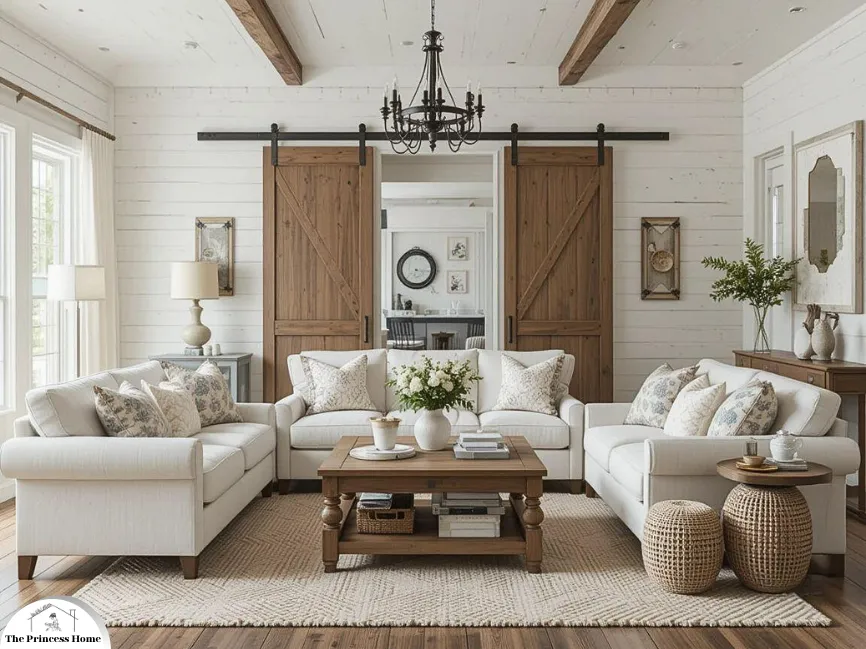
3. Farmhouse Style
Inspired by rural living, farmhouse style is all about creating a cozy and welcoming atmosphere. It blends rustic elements with a sense of practicality, featuring large, comfortable furniture and décor that celebrates the beauty of natural materials. The color palette is often a mix of whites, creams, and soft pastels, accented with darker wood tones and vintage-inspired accessories.
Key elements include shiplap walls, barn doors, and a mix of antique and modern furnishings that provide a relaxed yet functional vibe. This style is perfect for those who enjoy the warmth of a country home but with a touch of modern flair. To enhance the warmth and welcoming nature of farmhouse style, here are additional ideas for creating a home that’s both cozy and functional:
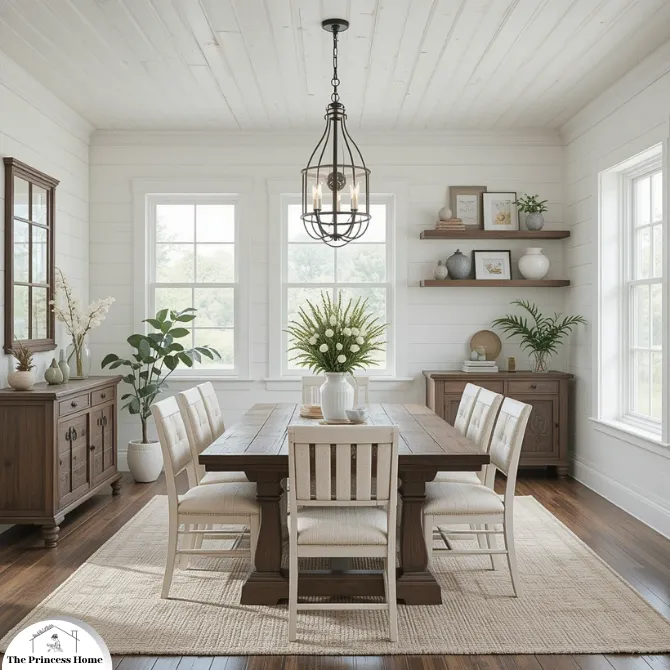
Shiplap Walls & Neutral Color
Use shiplap to create texture and character on walls or ceilings. It works beautifully in living rooms, kitchens, or bathrooms, offering a rustic yet refined backdrop that highlights the farmhouse style’s charm. Stick to whites, creams, soft grays, and muted pastels for walls, furniture, and textiles. You can accent these lighter tones with darker wood furniture and accessories, such as a farmhouse dining table or vintage wooden shelves.
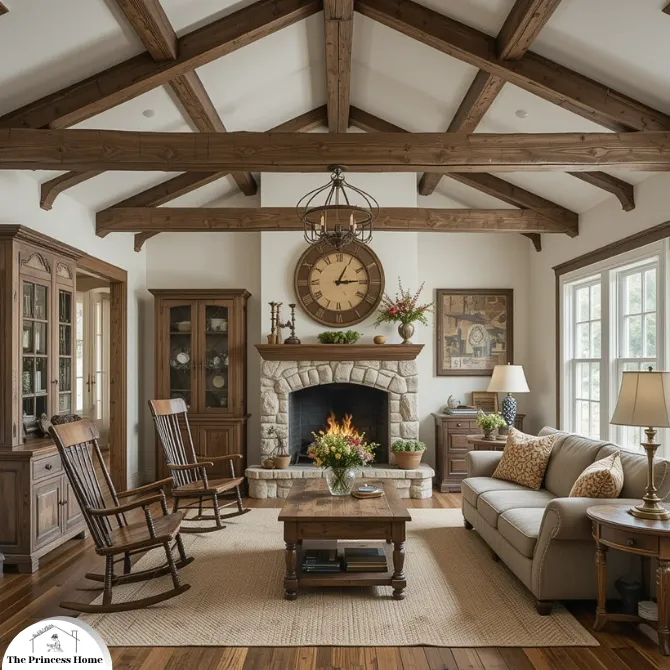
Exposed Beams & Vintage
Whether in the ceiling or as a feature on the walls, exposed wooden beams add rustic charm and create an open, airy feel, perfect for achieving a farmhouse look with a touch of sophistication. Incorporate antique or vintage furniture pieces such as old wooden rocking chairs, weathered cabinets, and reclaimed wood furniture. These elements can give your home character and tell a story.
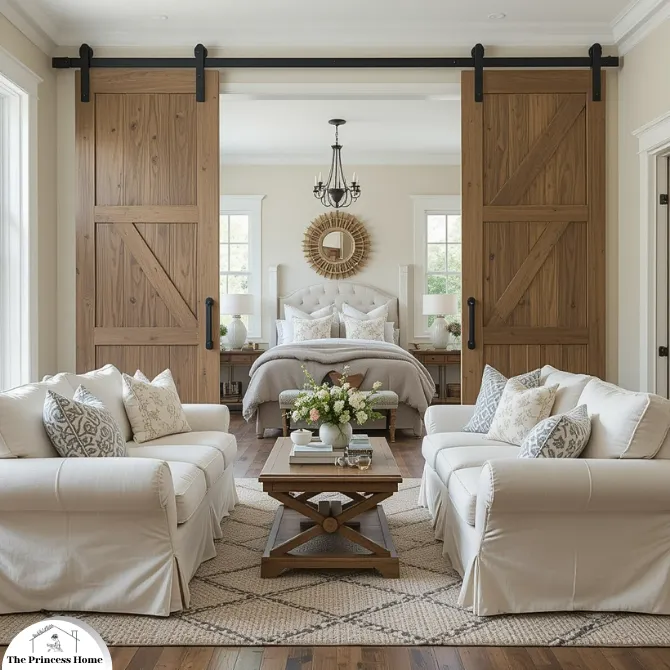
Barn Doors& Overstuffed Furniture
Install sliding barn doors for a functional yet stylish way to separate spaces, adding a touch of rustic elegance to rooms like the bedroom, bathroom, or pantry. Choose oversized, comfortable sofas and chairs with slipcovers in neutral fabrics, like linen or cotton. This promotes a relaxed, welcoming feel, perfect for lounging.
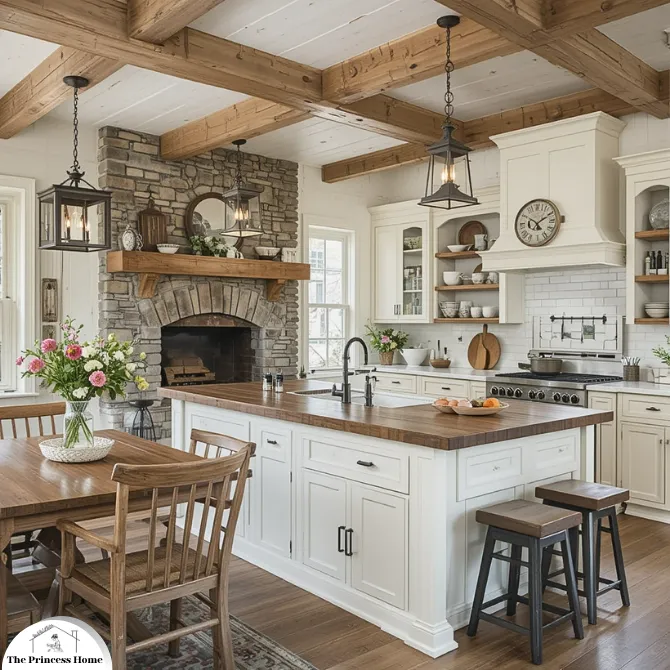
Natural Materials & Farmhouse Kitchen
Incorporate plenty of wood, stone, and metal throughout the space. A wooden dining table with mismatched chairs, a stone fireplace, or metal light fixtures can all contribute to the authentic farmhouse atmosphere. For the kitchen, mix modern appliances with classic farmhouse touches like a farmhouse sink, open shelving, and vintage-style kitchenware. A large island with stools creates an inviting space for family gatherings.
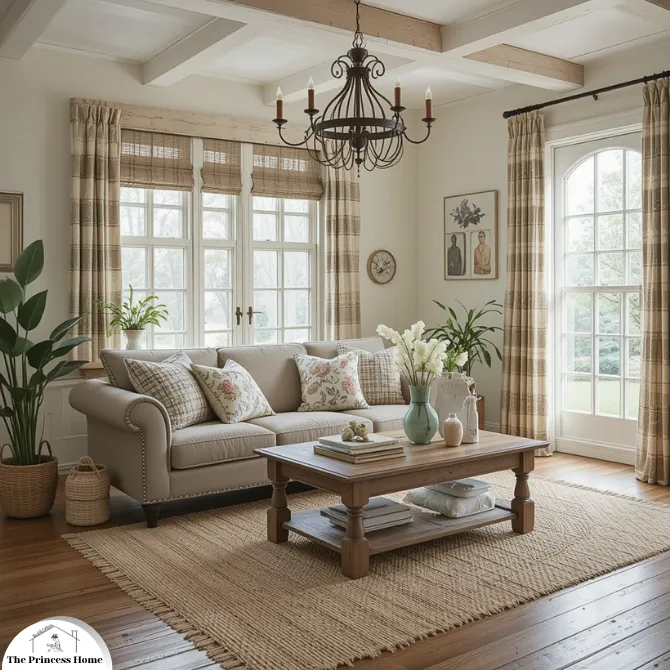
Woven Baskets & Textiles
Use woven baskets, wooden crates, or galvanized metal bins for storage. These rustic containers can hold everything from fresh linens to firewood and add a functional yet stylish touch to your home. Layering rugs in jute, sisal, or wool adds warmth and texture to the floors. Consider plaid, gingham, or floral prints for cushions, throws, and curtains to add depth and a sense of country charm.
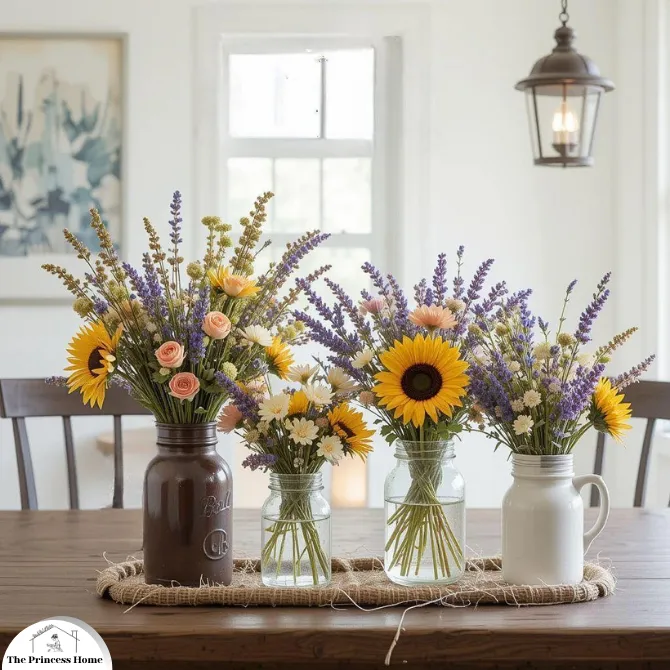
Floral Arrangements & Lighting
Fresh or faux wildflowers, sunflowers, or lavender in mason jars or vintage pitchers can bring a natural, seasonal touch to the décor. These arrangements enhance the farmhouse feel while adding color and fragrance. Choose simple yet elegant light fixtures such as barn-style pendant lights, wrought iron chandeliers, or lantern-inspired sconces to provide both functional lighting and rustic appeal.
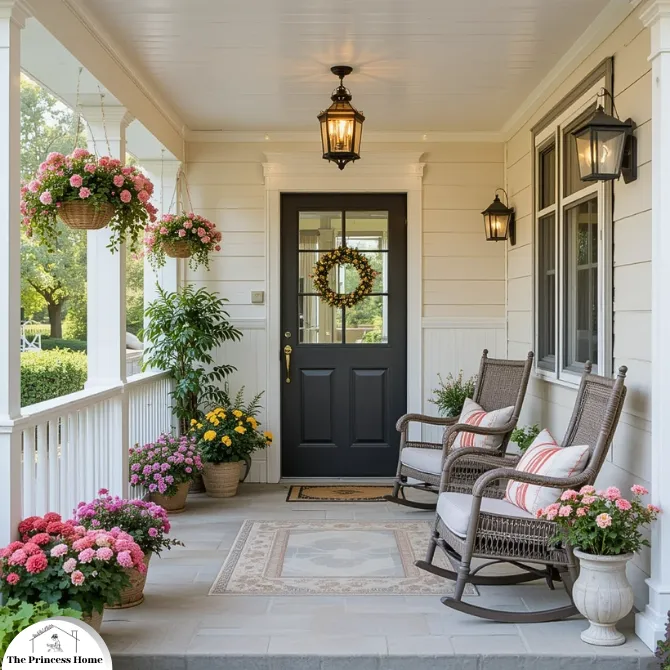
Porch and Outdoor Spaces
These small touches help make the space feel like home. Extend the farmhouse charm to your porch with rocking chairs, wicker furniture, and hanging baskets of flowers. String lights or lanterns can create a cozy, inviting outdoor environment.
By combining these elements, you can create a farmhouse-style home that’s full of warmth, character, and comfort, with just the right mix of rustic charm and modern elegance.
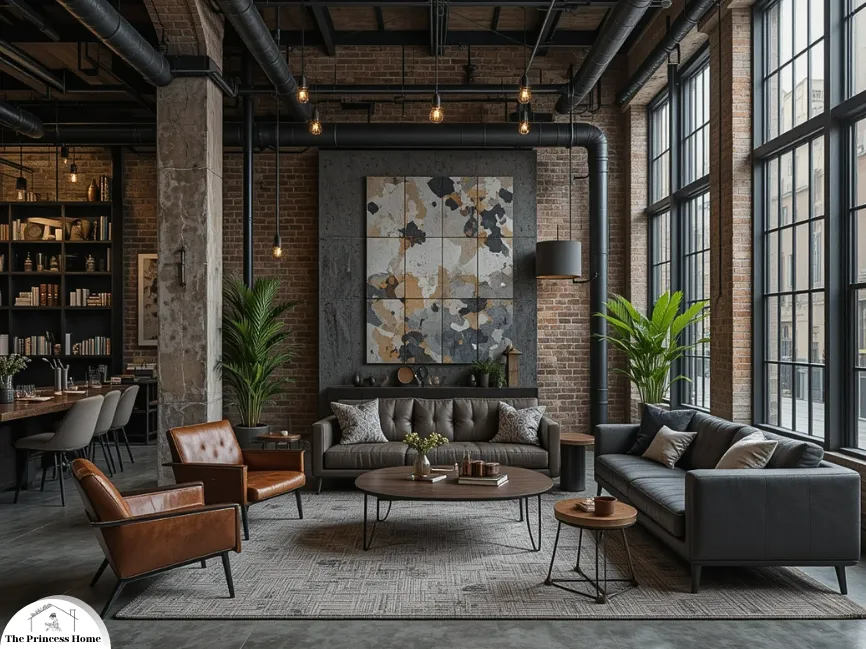
4. Industrial Chic
Industrial chic takes inspiration from old factories and warehouses, offering a bold and edgy design aesthetic. This style often combines raw, unfinished materials like brick, metal, and concrete with modern furnishings to create an urban, trendy feel. The color scheme tends to be darker with shades of gray, black, and brown, balanced by sleek furniture pieces and exposed pipes or beams.
Industrial chic thrives on the juxtaposition of rough textures with polished elements, such as leather chairs and vintage lighting fixtures. This style is perfect for those who love a more urban, utilitarian vibe in their home. To bring the bold and edgy feel of industrial chic into your home, here are some additional ideas for achieving this unique design aesthetic:
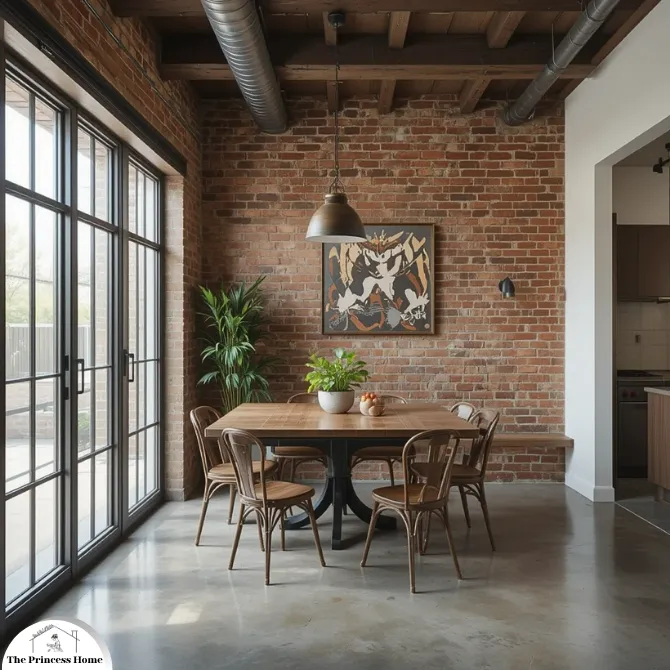
Exposed Brick Walls & Concrete
One of the hallmark features of industrial chic is exposed brick. Whether it’s the whole wall or a small accent area, brick brings texture and warmth to the space, while maintaining the raw, unfinished appeal of the style. Use concrete as a flooring option or wall treatment to add an industrial feel. Polished concrete floors are particularly effective in creating a sleek, urban vibe, while retaining the rugged charm of industrial design.
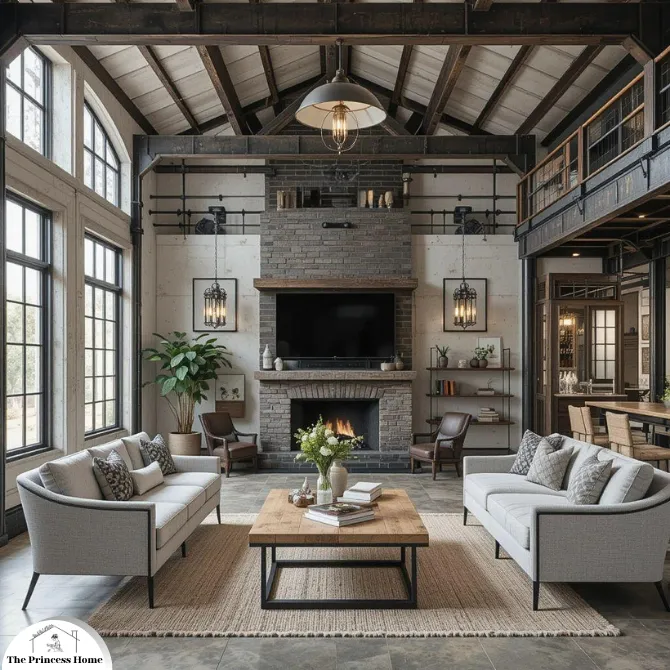
Metal Accents & Open Spaces
Incorporate steel or iron elements in your furniture, light fixtures, or accessories. Metal-framed chairs, steel shelving units, or exposed steel beams contribute to the industrial aesthetic. Industrial chic thrives in open, spacious environments. High ceilings with exposed beams, lofted spaces, or large open-plan rooms allow for the freedom to showcase the raw beauty of the materials.
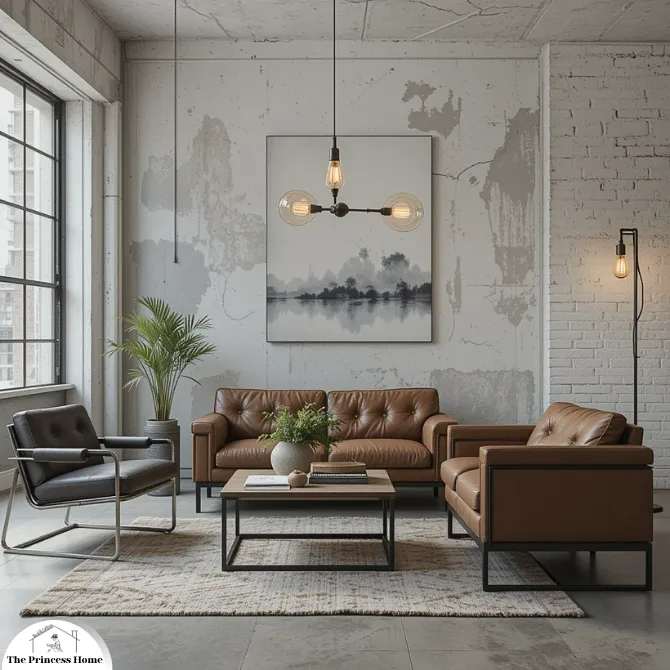
Modern Furniture & Vintage Lighting
Pair the rugged elements with minimalist, sleek, and functional furniture pieces. Leather sofas, metal-framed coffee tables, and simple, clean-lined chairs work well in an industrial chic setting. Incorporate vintage-style lighting fixtures like Edison bulb pendant lights, industrial sconces, or floor lamps with exposed wiring. These light sources add an authentic touch while providing an urban, nostalgic feel.
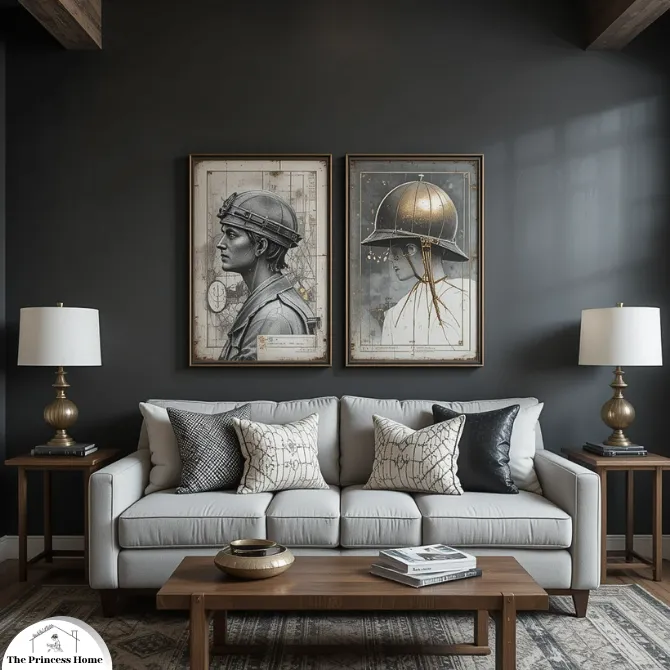
Neutral Color& Industrial Art
While the foundation is often dark, using neutral shades like grays, blacks, and whites can keep the space feeling grounded and sophisticated. You can balance the darker tones with pops of metallic accents, such as brass or copper, for added warmth. Add wall art that complements the industrial theme, such as vintage advertisements, framed metal prints, or abstract art with metallic touches. Large, bold art pieces add personality and a modern touch.
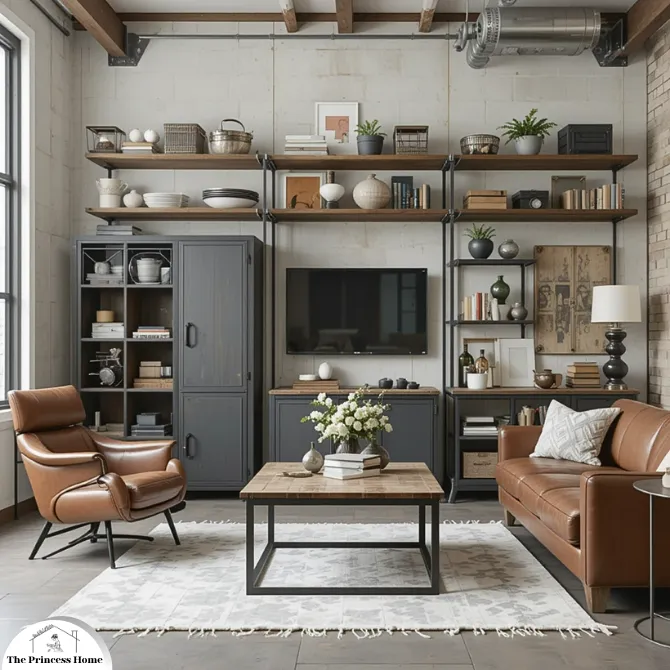
Functional Solutions & Leather
Use industrial-style shelves, open cabinetry, and metal storage bins to maintain a practical and utilitarian vibe. Wire baskets, metal lockers, or wooden crates can also be used for stylish, functional storage. Incorporate raw, unfinished wood or reclaimed wood in furniture or décor, such as a wooden dining table or shelving units. Leather furniture, like a leather chair or sofa, adds comfort and luxury, while fitting into the industrial chic theme.
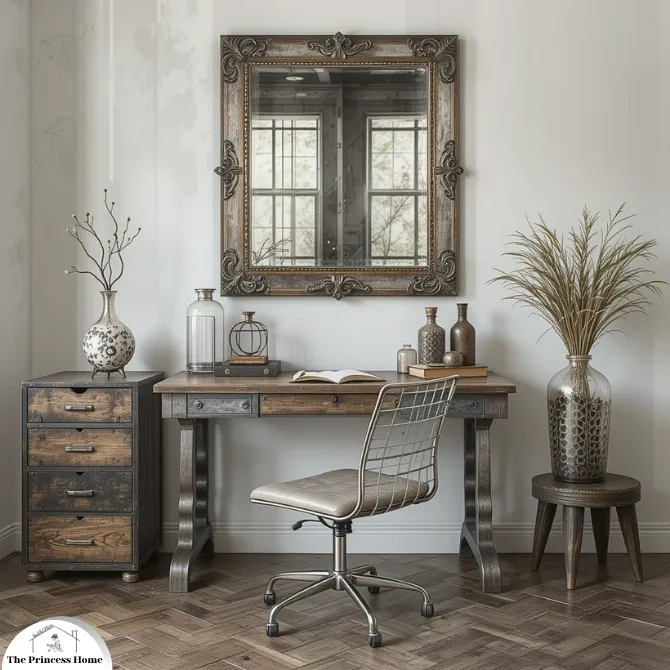
Mixing Modern & Antique
Combine industrial elements with mid-century modern or antique furniture for a more eclectic look. A vintage metal desk paired with a sleek, modern office chair, or an antique mirror framed in metal, adds character and a touch of personality. Keep accessories to a minimum, allowing the raw beauty of the materials and the space itself to shine. A few well-placed vintage books, metal sculptures, or simple glass vases can add interest without cluttering the space.

Industrial Kitchen:
Incorporate stainless steel appliances, open shelving, and exposed piping in the kitchen to maintain an industrial edge. A metal bar cart, reclaimed wood countertops, and vintage-style lighting make for a stylish yet functional kitchen.
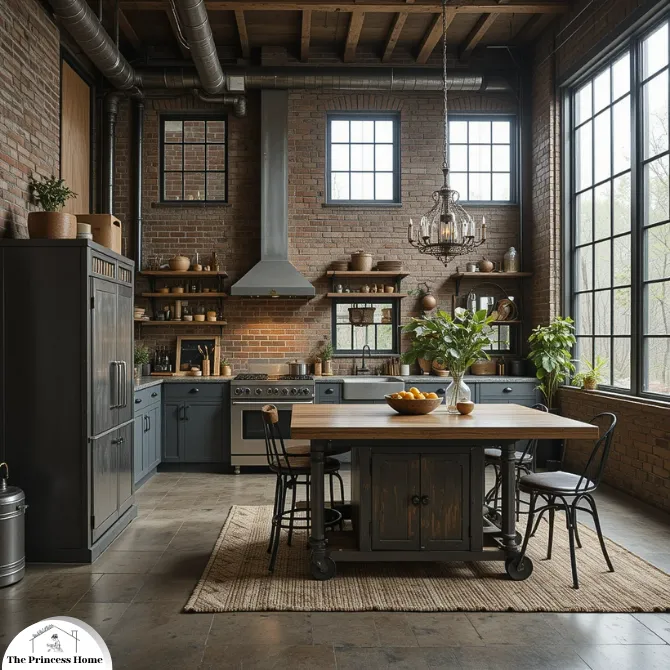
Large Windows & Industrial Finds:
If possible, emphasize large, industrial-style windows that bring in plenty of natural light. This adds to the raw aesthetic and helps the space feel more open and airy. Consider incorporating repurposed industrial pieces, such as a reclaimed factory cart turned coffee table, metal lockers as bedroom storage, or old pipes converted into a shelf or a light fixture.
By blending these rugged, utilitarian elements with sleek, modern touches, industrial chic can transform your home into a stylish, urban retreat that exudes personality and edge.
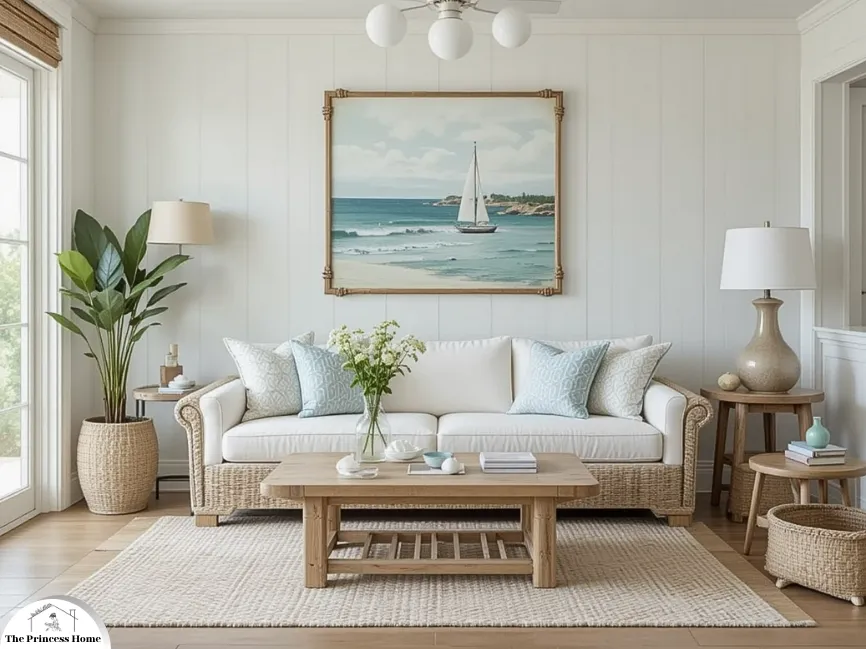
5. Coastal Living
Coastal living is all about bringing the relaxed vibe of the beach into your home. This style incorporates light, airy colors, such as whites, pale blues, and soft greens, to create a sense of tranquility. Natural materials like wicker, jute, and driftwood are common, giving your space a breezy, laid-back feel. Coastal living emphasizes clean lines and an uncluttered space, with décor that draws inspiration from the ocean, like nautical-themed art, sea glass, and natural textures. This style is ideal for those who want to evoke the peace and serenity of coastal life, no matter where they live. To fully embrace the serene and breezy atmosphere of coastal living, here are some ideas to incorporate this style into your home:
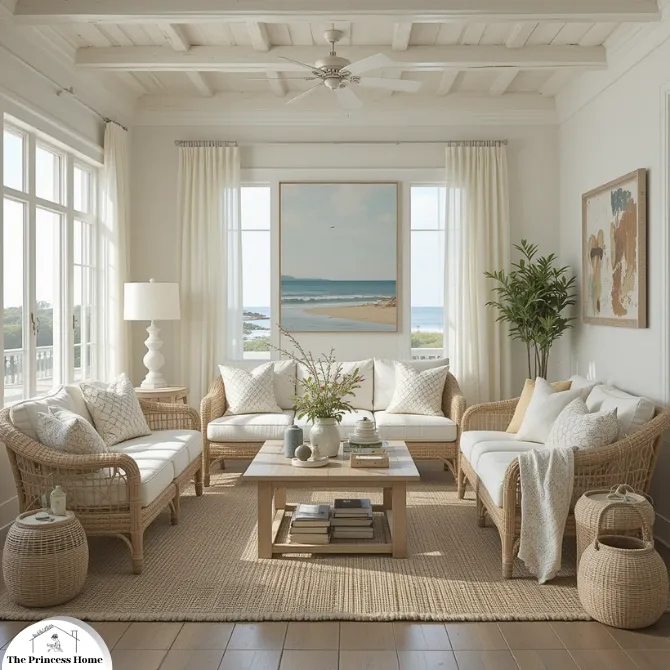
Soft Color Palette & Natural Textures
Use soft, neutral shades like whites, creams, pale blues, seafoam greens, and sandy beiges. These light colors evoke the calmness of the ocean and create an airy, open feeling in your space. Incorporate materials like wicker, jute, rattan, and linen into furniture and décor. These textures bring a natural, earthy feel to the space, reminiscent of beachside living.
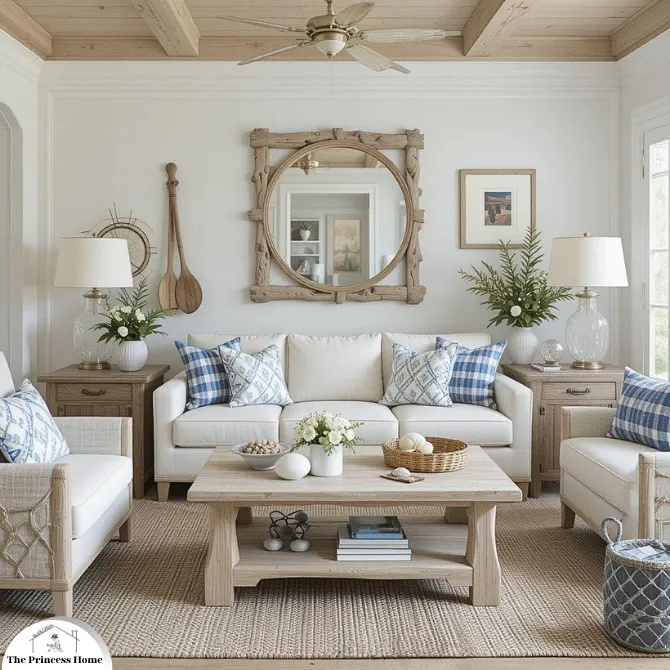
Wooden Elements & Nautical-Inspired Décor
Use light, weathered wood or reclaimed wood furniture to mimic the look of driftwood found on the beach. Wooden accent pieces, like a driftwood mirror or coffee table, add a rustic charm. Subtle nautical touches, such as stripes, anchors, ropes, and seashells, can evoke the seaside while maintaining a sophisticated feel. Consider nautical artwork or decorative objects like glass floats, ship wheels, or vintage oars.

Sheer Curtains & Ocean-Inspired Artwork
Use sheer or light linen curtains to allow natural light to flood the room. The soft fabric will also give the space a breezy, ethereal vibe, mimicking the feeling of being near the ocean. Incorporate art that reflects the sea, such as paintings or photographs of coastal landscapes, seashells, coral, or boats. Subtle ocean themes add character while reinforcing the peaceful, coastal aesthetic.
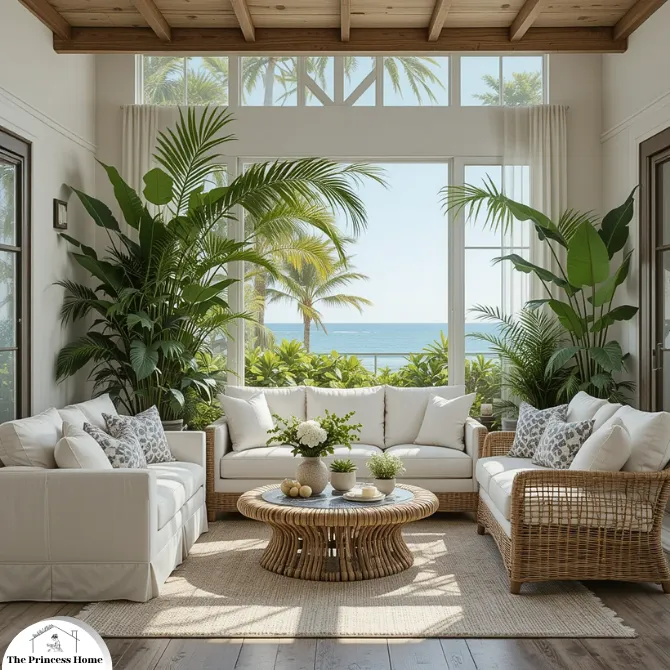
Indoor Plants & Casual Furniture
Bring the outdoors in with tropical or coastal plants like palms, ferns, and succulents. They add a fresh, natural touch that complements the beachy atmosphere. Choose light, comfortable furniture like slipcovered sofas in neutral fabrics, oversized armchairs, or wicker seating. The focus is on creating a relaxed and inviting atmosphere with plenty of seating options.
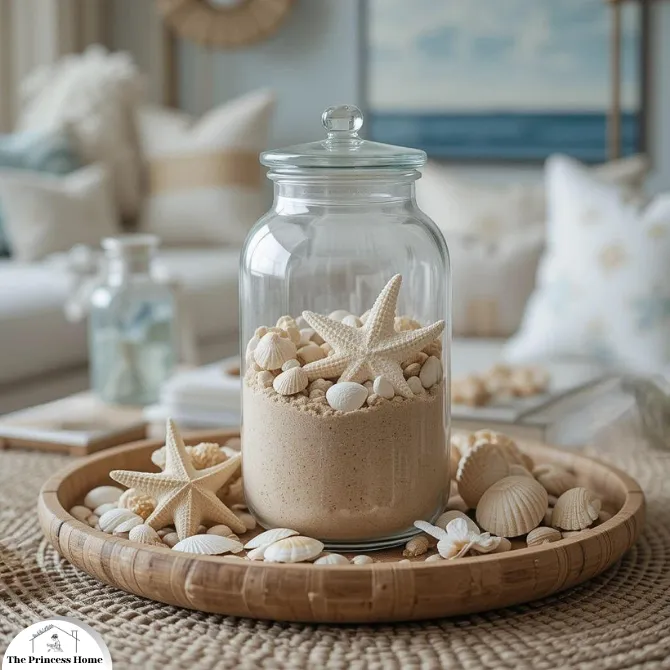
Light, Airy Rugs & Coastal Accessories
Opt for woven or sisal rugs that add texture without overwhelming the space. Rugs in soft, neutral tones help anchor the room while maintaining the light and airy feel. Incorporate seashells, starfish, and sand dollars in vases or as accents on tables. A large glass jar filled with sand and seashells can create a simple, beach-inspired centerpiece.
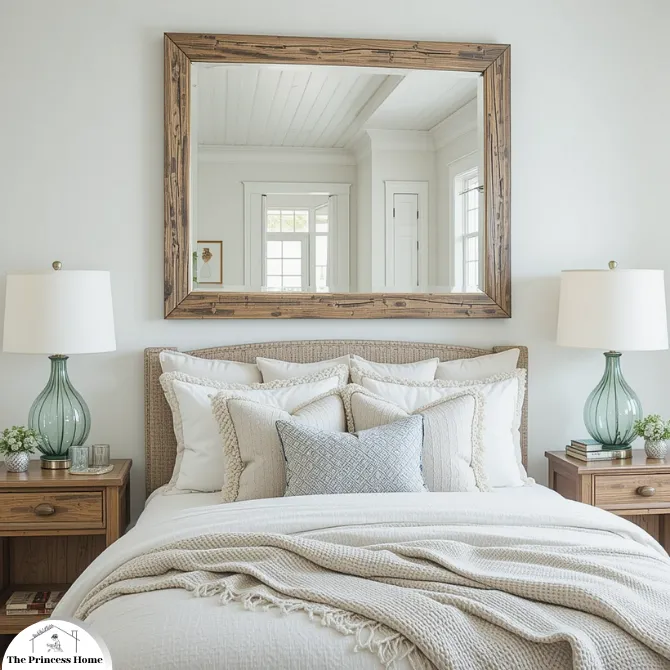
Glass Elements & Cotton Fabrics
Use glass vases, lamps, and mirrors to reflect light and mimic the sparkle of the ocean. A large mirror with a weathered wood frame can create a focal point while adding to the coastal charm. Use linen or cotton bedding, cushions, and throws in light colors for a relaxed, beachy feel. These breathable fabrics add to the comfort of your coastal-inspired home.
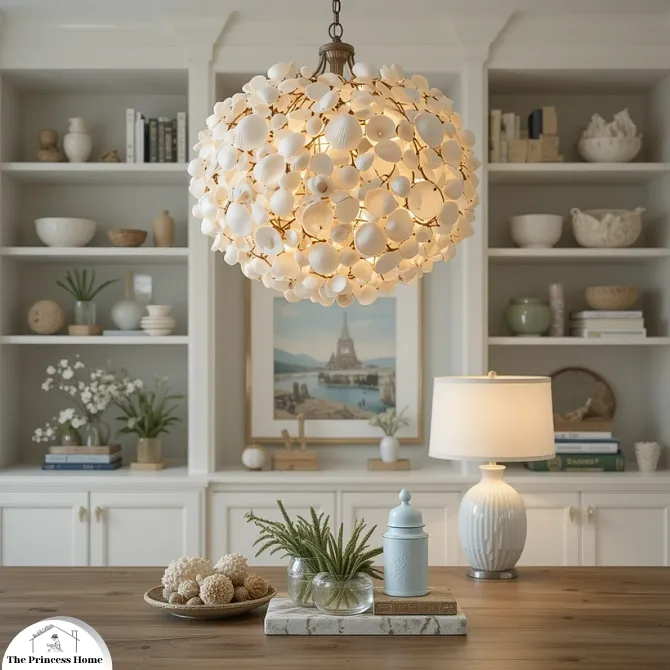
Coastal Lighting & Open Shelving
Opt for light fixtures that evoke the feel of being near the water, like a chandelier made from seashells, a lantern-inspired pendant light, or a table lamp with a nautical design. Keep your space uncluttered with open shelving or minimalist storage solutions. Display natural elements like sea glass, driftwood, or coastal books, keeping the vibe relaxed and organized.
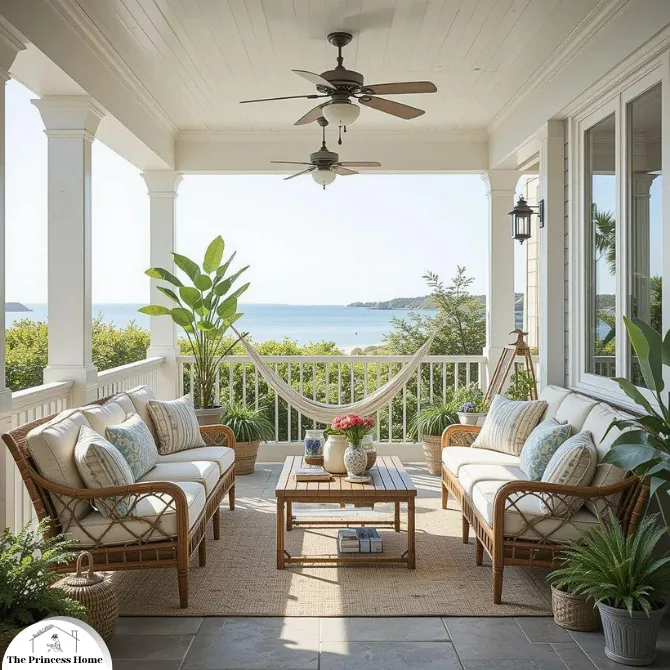
Patio or Porch:
If you have an outdoor space, create a serene coastal oasis with comfortable seating, light cushions, and natural elements like potted plants, lanterns, or a hammock.
By blending these elements, you can create a coastal living-inspired home that brings the peace, serenity, and beauty of the beach into your everyday life, no matter where you are.
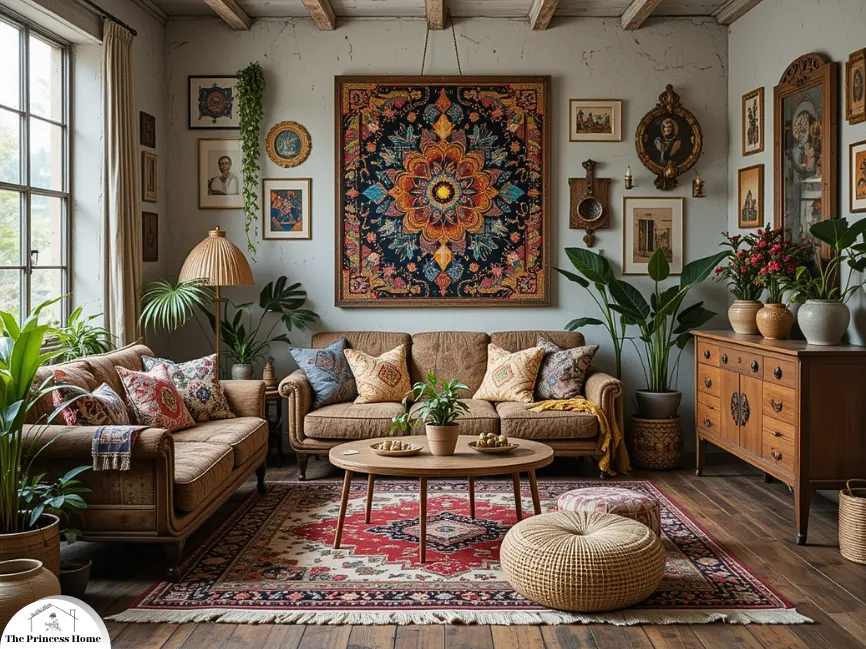
6. Bohemian Bliss
Bohemian style, or “Boho,” is a reflection of creativity, individuality, and a carefree approach to design. It incorporates a wide variety of colors, patterns, and textures, often blending cultural influences from around the world. Furniture is often mismatched and vintage, with an emphasis on comfort and personal expression. Think colorful rugs, textured pillows, and eclectic wall art that tells a story. Wooden furniture, plants, and woven baskets add an organic feel to the space. Bohemian bliss is perfect for those who want their home to feel lived-in, unique, and full of character. To bring the vibrant and eclectic vibe of Bohemian bliss into your home, here are some ideas to capture the essence of this carefree and creative design style:
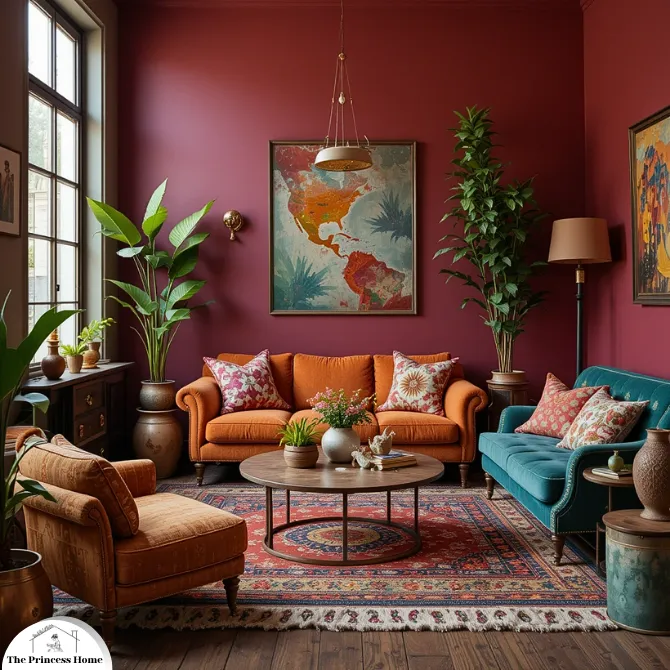
Rich, Layered Colors & Eclectic Furniture
Use a mix of bold, vibrant colors such as deep reds, purples, oranges, and greens. These can be paired with earthy tones like browns, mustards, and ochres. The more layers of color, the better to create a cozy, energetic atmosphere. Mismatched furniture is a hallmark of the Boho style. Incorporate vintage, secondhand, or antique pieces. A combination of wooden, metal, and upholstered furniture with different styles can bring a sense of individuality to the space.
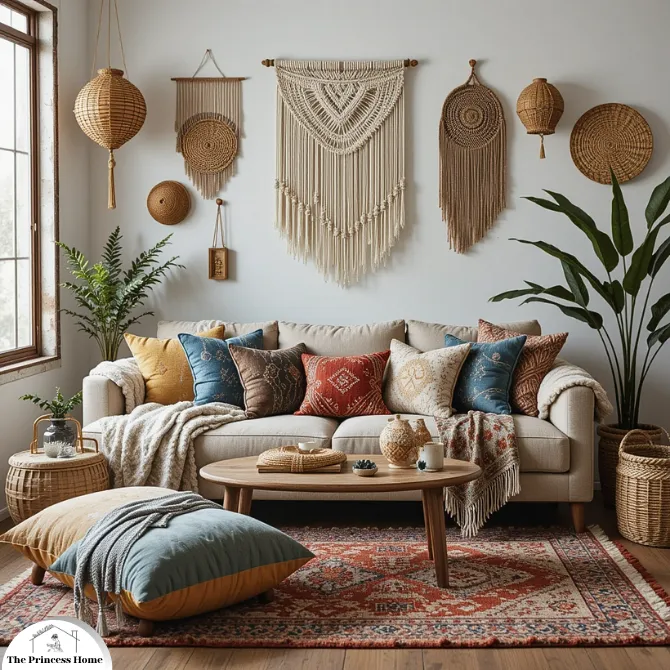
Textural Variety & Global Influence
Layer various textures to create a rich, tactile experience. Think shaggy rugs, velvet cushions, woven throws, macramé wall hangings, and tasseled pillows. These elements add depth and comfort to the room. Bohemian design is deeply inspired by global travel. Include ethnic patterns, such as Moroccan rugs, Indian tapestries, Turkish textiles, or African baskets. These add cultural richness and tell a story about your unique style and experiences.
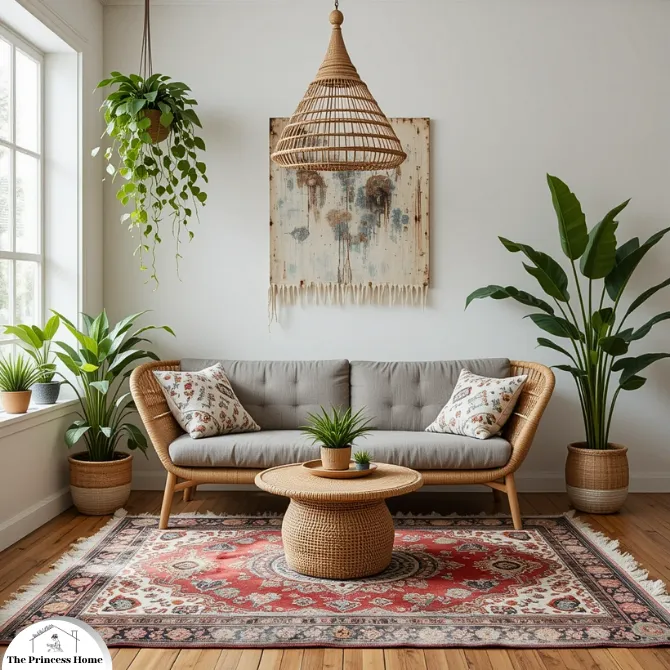
Greenery & Bold Rugs
Add plenty of indoor plants to bring life and natural beauty into your space. Hanging plants, large leafy plants, or small potted succulents work well in Boho spaces. They bring a touch of nature indoors and enhance the laid-back vibe. Area rugs are essential in Bohemian decor. Choose colorful, patterned, or vintage rugs to ground your space. Layering rugs of different sizes and styles creates a dynamic, warm environment.
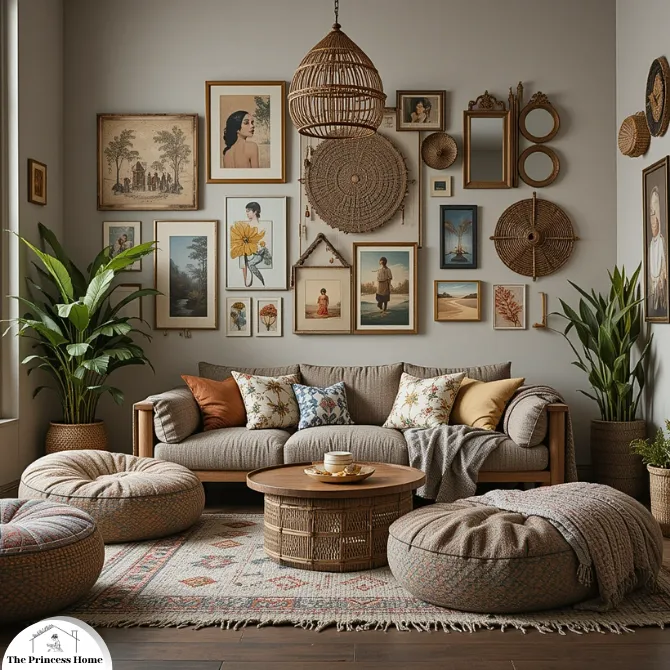
Artistic Wall Decor & Casual Seating
Decorate your walls with eclectic artwork, including abstract paintings, photographs, mirrors, and woven textiles. Mix and match frames or even leave them unframed for an unpolished, creative look. Opt for low seating options like floor cushions, poufs, or oversized bean bags to create a relaxed atmosphere. A comfy, oversized sofa or hammock is also a great way to bring a Boho touch to your home.
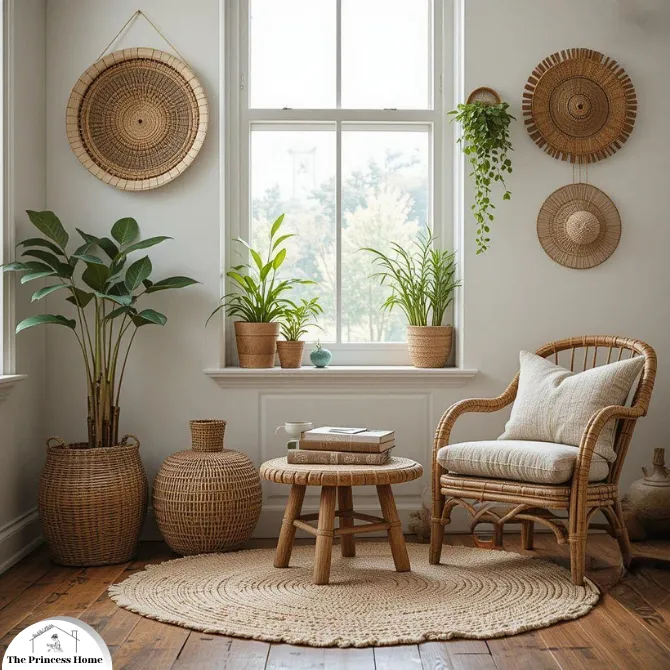
Woven Baskets & Upcycled Finds:
Use woven baskets for both storage and decoration. These can be placed on the floor, hung on walls, or used to hold plants or blankets. Their organic texture adds an earthy touch. Embrace the charm of vintage or upcycled furniture and accessories. A mix of old and new pieces brings character and a sense of history to the space, making it feel unique and lived-in.
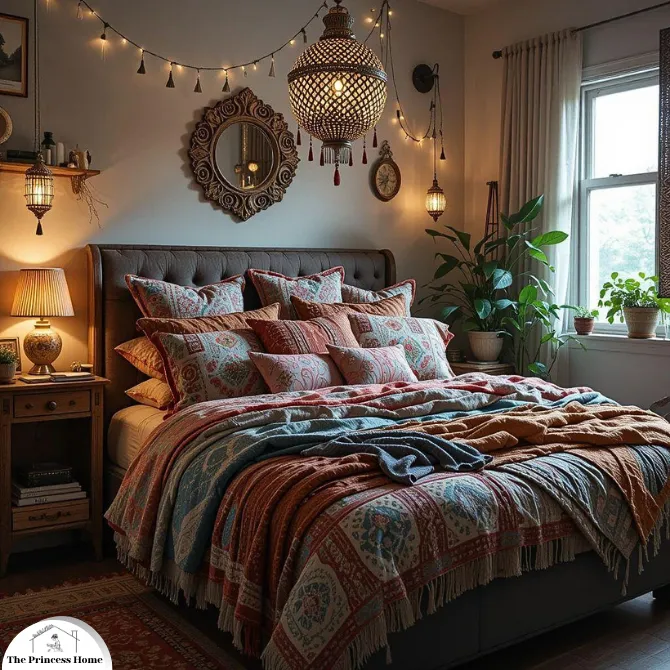
Creative Lighting & Boho Bedding
Layer your lighting with a mix of natural light, table lamps, string lights, and floor lamps with intricate designs. Boho lighting often includes unique, statement pieces like lanterns, Moroccan-style lamps, or chandeliers with beads and tassels. For the bedroom, think of a cozy bed piled high with mismatched pillows, blankets, and throws. Choose colorful, patterned bed linens or even a quilt with a global-inspired design.
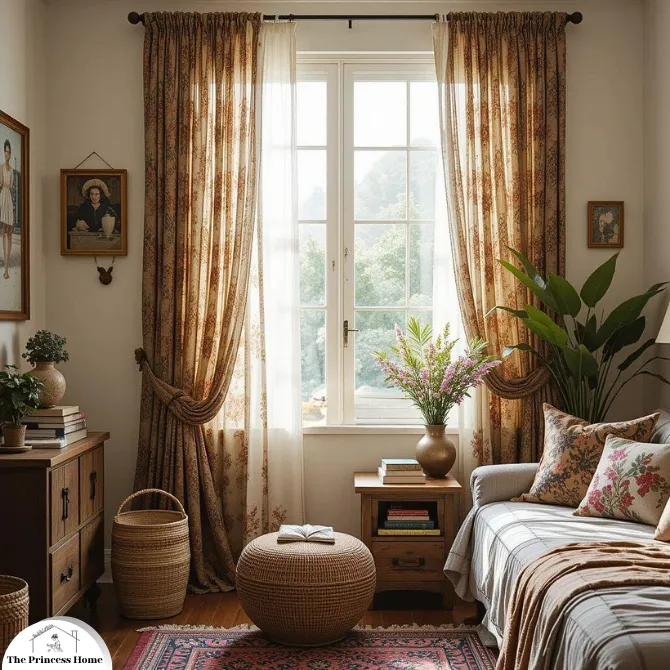
Personal Expression & Layered Curtains
Above all, Bohemian style is about personal expression. Decorate with items that reflect your personality and passions—whether that’s handmade art, sentimental objects, or books and trinkets that tell your story. Use flowing, sheer curtains or fabrics in rich patterns. Layer them to create depth and movement, allowing natural light to filter softly into the room while maintaining a relaxed, airy feel.
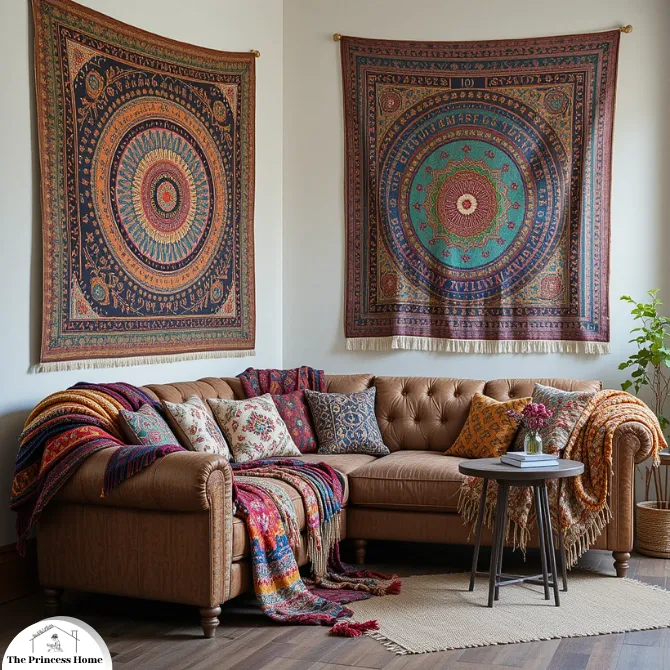
Tapestries and Throws
Hang large tapestries on walls or drape them over furniture to add color and texture. A collection of vibrant throws can be layered over sofas or chairs to create warmth and comfort.
By blending a variety of colors, patterns, textures, and unique finds, you can create a Bohemian-inspired home that feels vibrant, comfortable, and full of character. Let your space reflect your personal journey and the joy of living authentically.
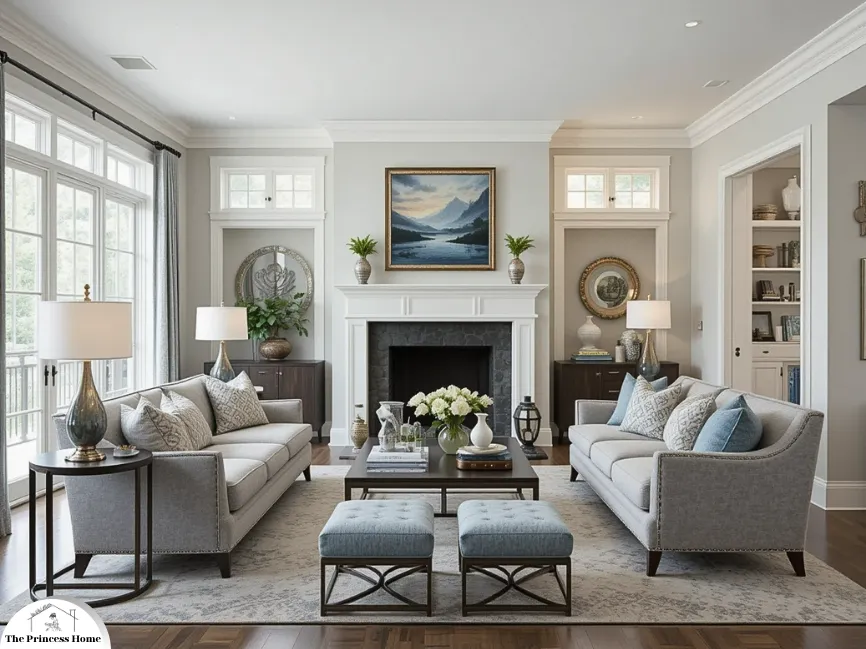
7. Transitional Style
Transitional design is all about blending traditional and contemporary styles to create a space that feels timeless and sophisticated. It focuses on smooth, clean lines and a balanced color palette that draws from both modern and classic influences. Furniture tends to have simple, elegant shapes but may feature rich fabrics or wood detailing that evokes traditional charm. Neutral tones, soft blues, and grays are common, while a mix of textures, like sleek metals and rich fabrics, adds depth and warmth. This style is ideal for those who appreciate the comfort of tradition but want a more updated, refined look. To incorporate transitional style into your home, here are some ideas that beautifully blend traditional warmth with contemporary simplicity:
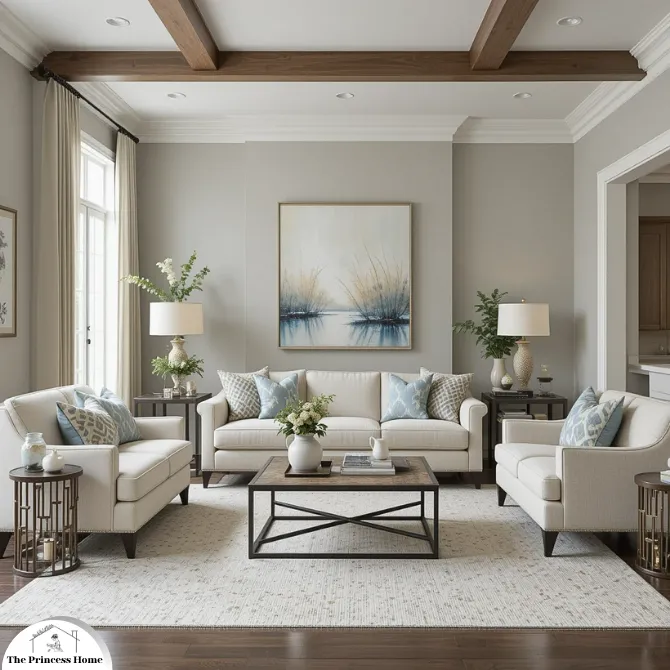
Neutral Color Palette & Elegant Lines
Focus on a soothing, balanced color scheme of neutral tones such as soft grays, beige, taupe, and ivory. Incorporate accents in soft blues or muted greens to add depth while maintaining a sophisticated feel. Furniture in transitional spaces often features smooth, straight lines without excessive ornamentation. Opt for pieces that combine simple, modern silhouettes with classic touches like subtle wood carvings or graceful curves.
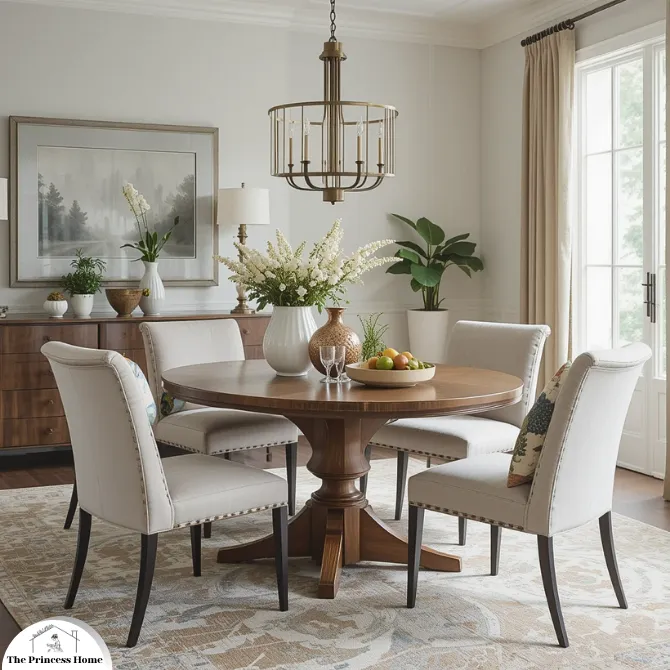
Mix of Materials & Rich Textures
Blend traditional and modern materials, such as pairing a traditional wood dining table with sleek metal chairs. Use soft fabrics like linen and velvet for upholstery alongside polished metal or glass for accent pieces. Layer different textures for added depth. Incorporate rich fabrics like velvet or silk for cushions, throws, or curtains, while using smooth materials like leather or metal for furniture accents.
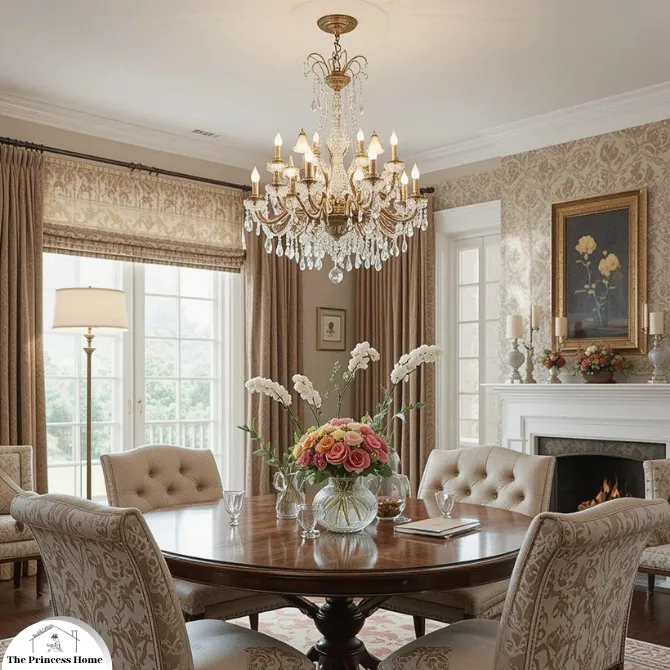
Lighting & Classic Patterns
Choose lighting that merges modern and traditional styles. Consider a chandelier with clean lines but traditional materials like crystal, or a sleek metal floor lamp paired with a timeless design. While the patterns may reflect traditional designs, such as floral or damask, they are often updated with a more contemporary color palette or simplified scale, blending the old with the new.
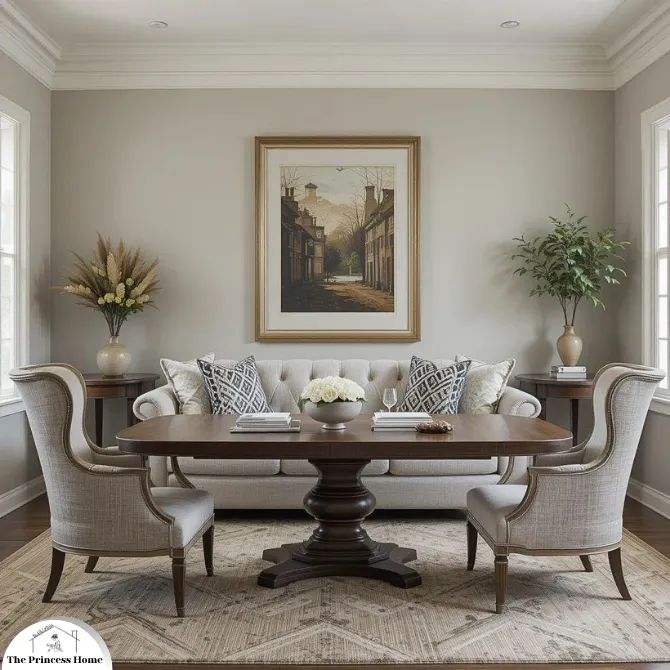
Timeless Furniture & Accent Pieces
Focus on timeless furniture pieces, like a tufted sofa, wingback chairs, or a classic wooden dining table. Look for designs that incorporate both traditional craftsmanship and clean, modern lines. Incorporate classic art pieces or vintage-inspired accessories, but keep them streamlined. Opt for framed abstract art, traditional ceramic vases, or simple metal sculptures that complement the refined aesthetic.
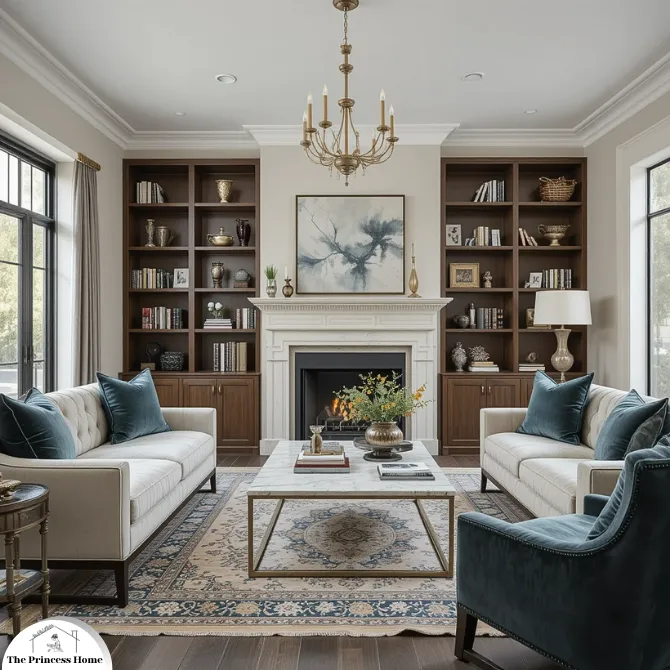
Wood ,Metal & Subtle Opulence
Transitioning between traditional and modern elements often involves the combination of rich wood finishes with sleek metals. For instance, mix a wood-paneled bookshelf with a modern metal frame to create a balanced look. Add elegance with luxurious, but not over-the-top, fabrics or finishes. Velvet cushions, a polished marble coffee table, or an antique rug can bring in a touch of refinement while maintaining balance.
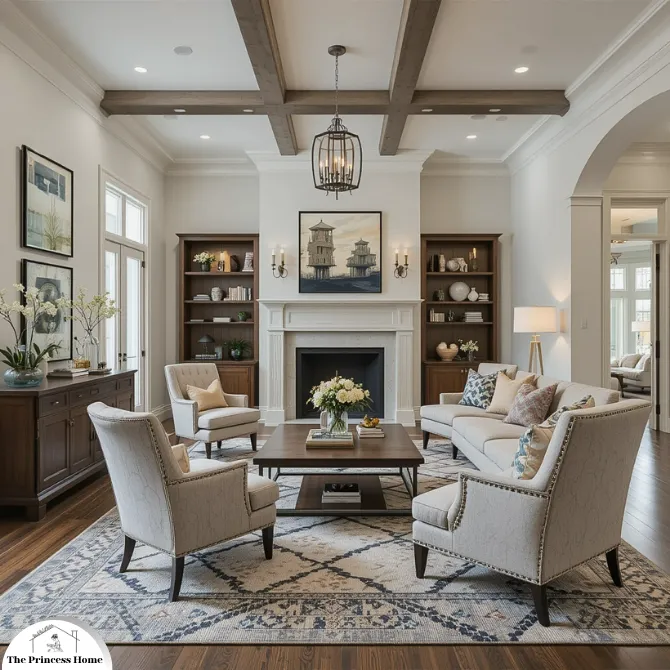
Open Spaces & Updated Traditional Details
While transitional spaces maintain an open layout, ensure the design elements define different zones. Use area rugs, lighting, or furniture placement to create clear but fluid spaces within the room. Consider using traditional design elements in a more contemporary manner. For example, choose a traditional-style fireplace with a modern surround, or a classic chair upholstered in contemporary fabric.
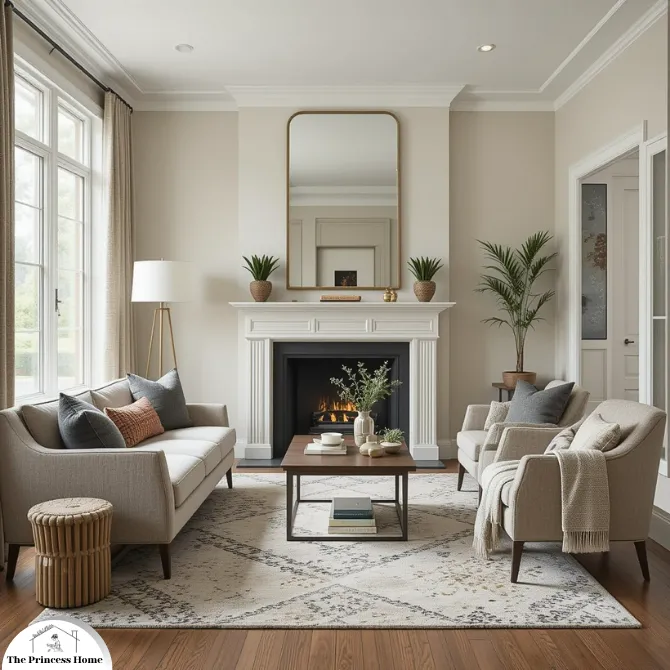
Minimalist & Neutral Flooring
Avoid excessive décor. Instead, opt for carefully selected pieces that reflect both eras. A statement mirror with a simple design or a minimalist floor lamp can serve as a focal point without overwhelming the space. Hardwood floors, neutral-toned rugs, or even natural stone flooring create a timeless foundation for any transitional space. Layer them with smaller accent rugs or throw blankets in more modern colors or patterns.

Blended Artwork
Mix modern art with traditional pieces to create a harmonious focal point. An abstract painting in soft tones could work beautifully next to a vintage-style wooden frame or a traditional print.
By striking the right balance between the comfort and charm of traditional design and the sleekness and simplicity of contemporary styles, transitional design creates a warm, inviting, and sophisticated space that feels timeless yet fresh.
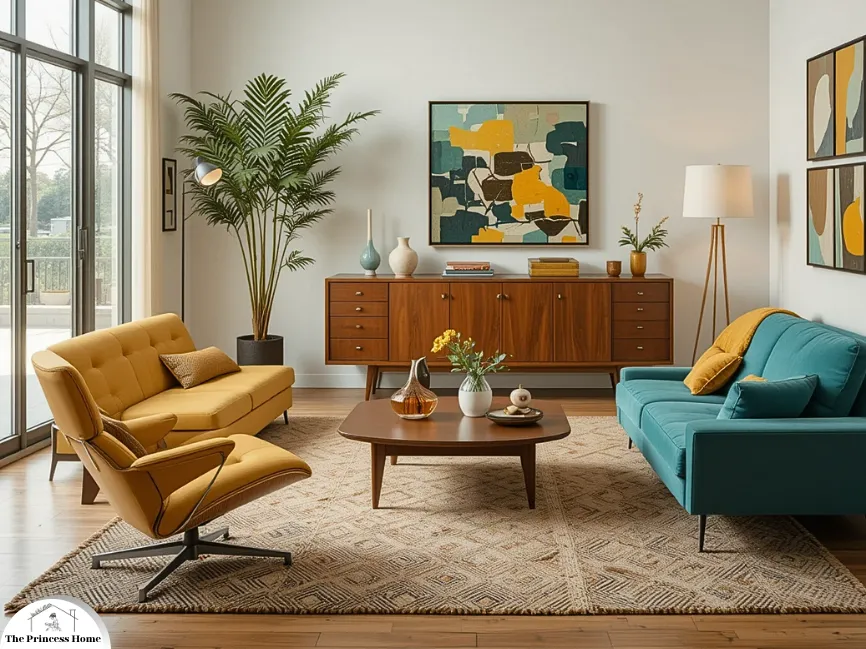
8. Mid-Century Modern
Mid-century modern design draws influence from the post-World War II era, combining sleek, simple lines with functional design. Furniture pieces are often low-profile, with clean, geometric shapes and a mix of organic and man-made materials like wood, metal, and plastic. The color palette is often rich and warm, with pops of bold colors like mustard yellow, teal, and olive green.
Iconic pieces like Eames chairs and angular coffee tables are staples of this style. Mid-century modern is perfect for those who love retro design but also appreciate functionality and simplicity. To bring the timeless appeal of mid-century modern design into your home, here are some ideas to create a sleek, functional, and vibrant space that celebrates the aesthetic of the post-World War II era:
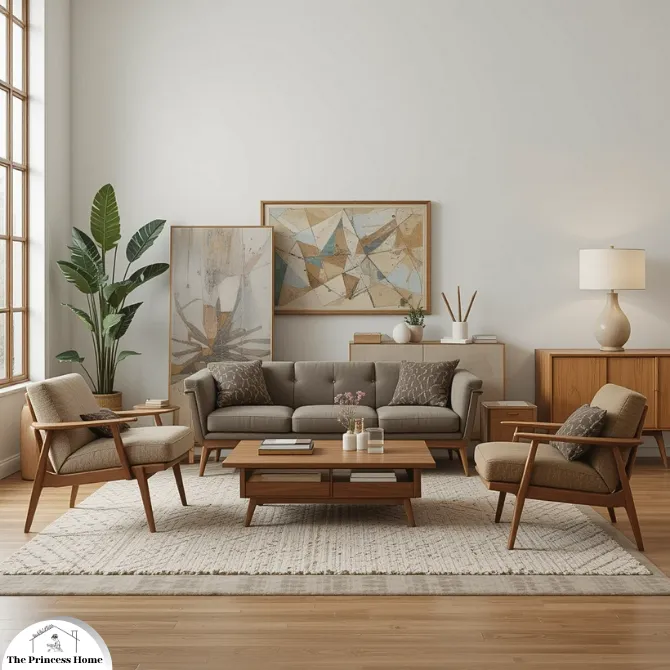
Geometric Shapes & Wood Tones
Furniture in mid-century modern style often features sharp, clean lines with angular or rounded edges. Look for low-profile sofas and chairs with slim, tapered legs. Tables and other furniture should have simple, geometric shapes that emphasize functionality. Incorporate natural wood, particularly walnut, teak, or oak, to bring warmth and texture to your space. Wooden furniture like coffee tables, sideboards, or bookshelves can be key pieces to define the mid-century modern look.
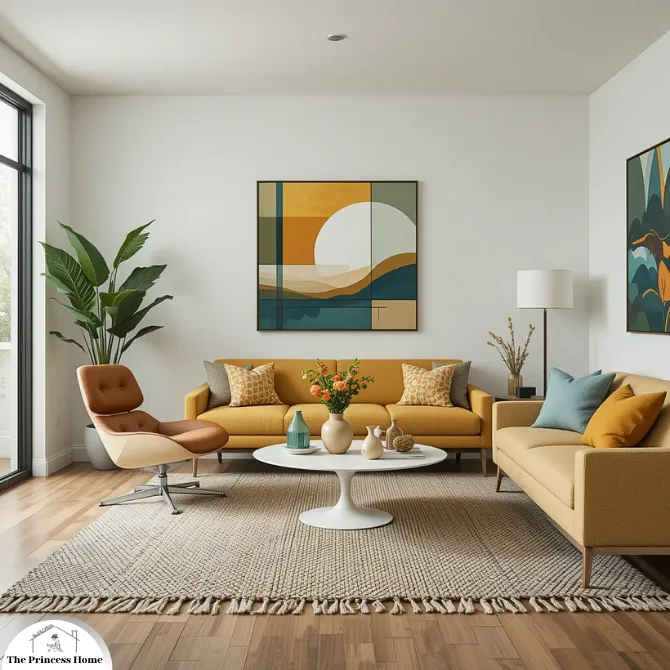
Bold Color Accents & Iconic Furniture
While the primary base color palette tends to be neutral—think whites, blacks, and grays—add pops of bold, retro-inspired colors like mustard yellow, teal, olive green, or burnt orange. These can appear in accent pieces like throw pillows, artwork, or small furniture pieces. Incorporate classic mid-century modern furniture designs, like an Eames lounge chair, a Saarinen Tulip table, or a sleek angular coffee table. These pieces are instantly recognizable and embody the style’s elegant simplicity.
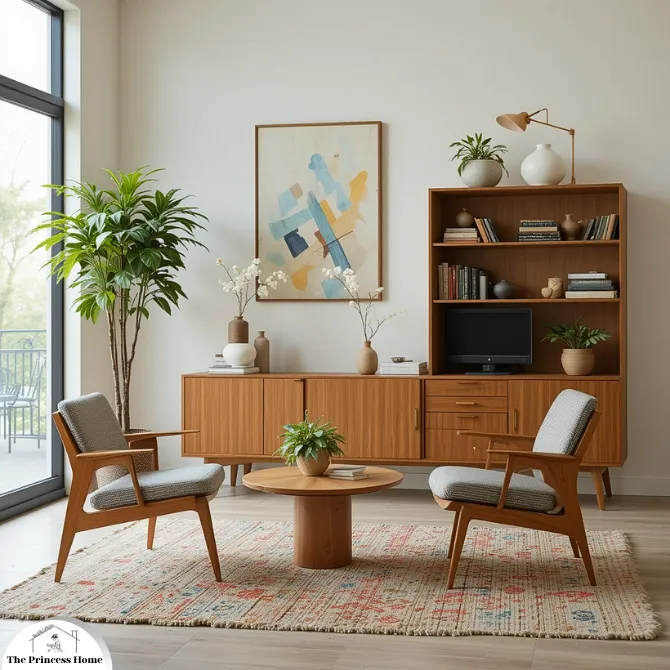
Functional Design & Natural Materials
Mid-century modern emphasizes functionality without sacrificing beauty. Look for furniture that is both practical and aesthetically pleasing, such as multi-functional storage solutions and comfortable yet minimalist seating. While wood is a dominant material, don’t shy away from incorporating man-made materials like molded plastic, fiberglass, or metal. For example, chairs with a wooden frame but plastic or fabric seating can highlight the mix of organic and synthetic materials typical of the style.
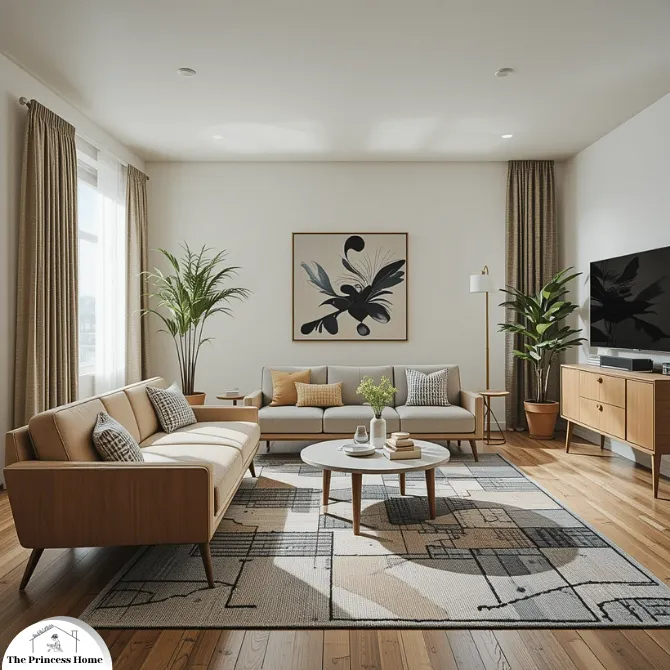
Uncluttered Spaces & Graphic Patterns
Mid-century modern spaces embrace open layouts and minimize clutter. Choose furniture with legs that lift off the ground to create an airy feel. Keep décor minimal and opt for clean lines, simple shapes, and strategically placed accessories. Bring in subtle textures or graphic patterns through rugs, curtains, or cushions. Think geometric designs, bold stripes, or simple mid-century-inspired patterns in textiles to add visual interest without overwhelming the space.
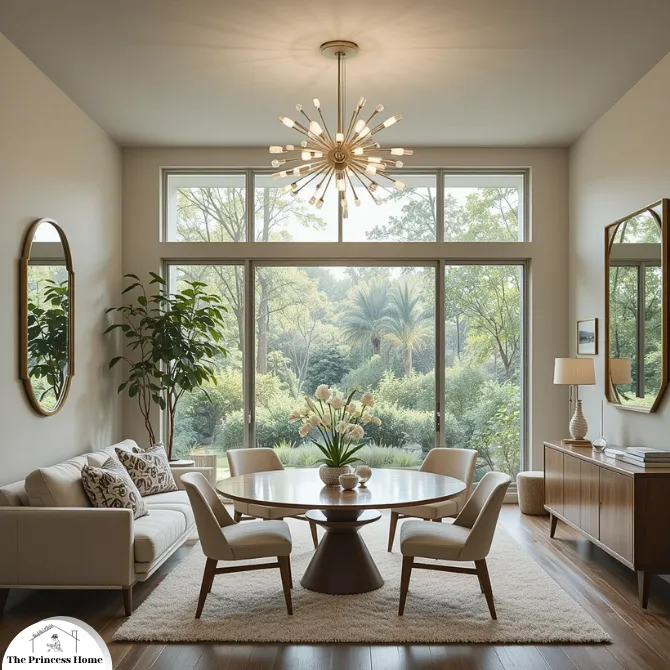
Statement Lighting & Large Windows
Lighting is key in mid-century modern design. Opt for iconic lighting fixtures, like starburst chandeliers or Sputnik-style pendant lights, that not only provide light but also serve as artful focal points. If possible, maximize natural light in your home. Mid-century modern homes often featured large windows to blend indoor and outdoor spaces. If large windows aren’t an option, strategically placed mirrors can reflect light and create a sense of openness.
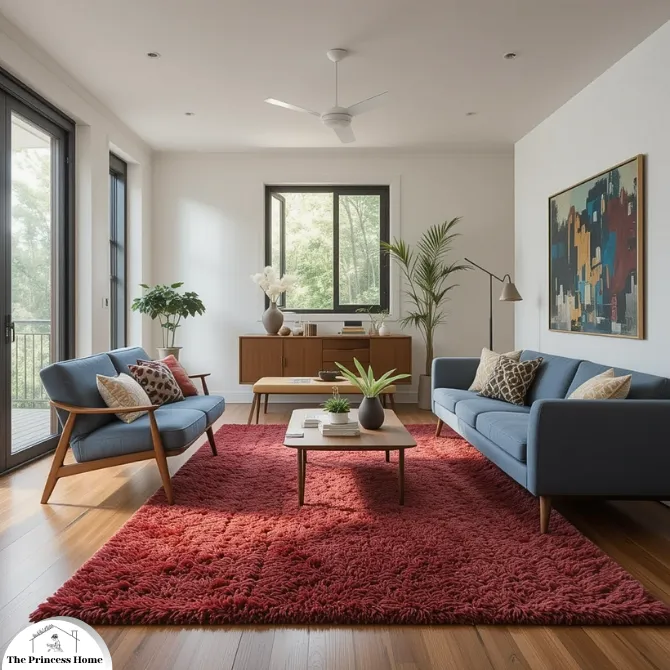
Neutral Flooring & Angled Legs
Opt for neutral flooring like hardwood or polished concrete, and layer bold-patterned rugs or shag rugs in rich, contrasting colors to anchor the room and add warmth and texture. Choose furniture with angled or splayed legs, a key feature in mid-century modern design. These can be seen in everything from sofas and chairs to coffee tables and sideboards, giving the pieces a light, elevated look.Mid-century modern walls are typically adorned with bold art pieces or minimalist designs. Consider hanging abstract paintings or framed prints, and add small decorative objects like ceramic vases or sculptures to add personality without clutter. I
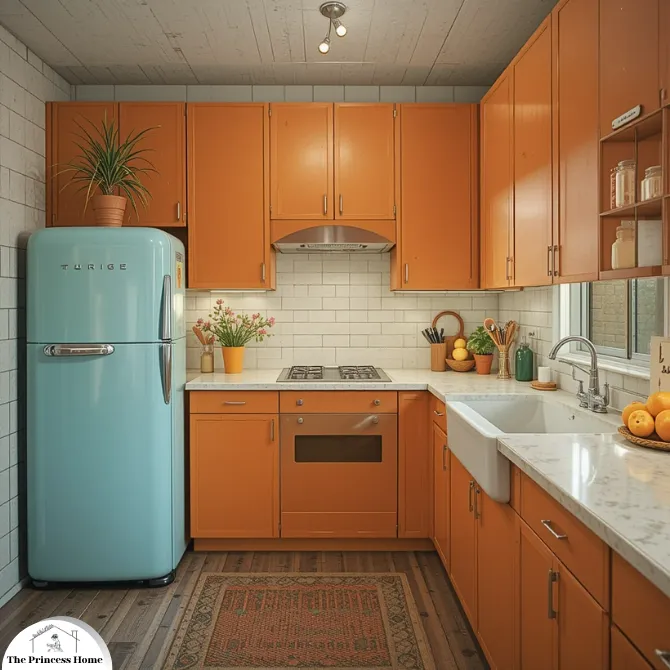
Simple Accessories & Retro Appliances
f you’re updating a kitchen or bathroom, consider using retro-inspired appliances and fixtures, such as a colorful refrigerator or a streamlined sink with a sculptural faucet, to incorporate mid-century modern flair.Keep accessories minimal and avoid excess. Instead, focus on carefully selected items like a simple vase with a single bloom, a sleek clock, or small sculptures. Each piece should contribute to the overall simplicity and elegance of the space.
By mixing clean lines, functional pieces, and a bold color palette with timeless design elements, you can create a space that not only feels like a tribute to mid-century modern style but also provides comfort and practicality. This style is ideal for those who appreciate the beauty of vintage design with a fresh, modern twist.

9. Contemporary Style
Contemporary design is constantly evolving, drawing from a variety of influences to stay current and fresh. It emphasizes clean lines, open spaces, and a neutral color palette, often accented with bold pops of color. Furniture tends to be streamlined and minimalist, with an emphasis on materials like glass, steel, and concrete. Contemporary spaces tend to be open and airy, with an emphasis on natural light and functionality. This style works well for people who like to stay on the cutting edge of design and prefer a modern yet adaptable aesthetic.
To create a contemporary style home that is sleek, functional, and on the cutting edge of design, consider these key elements that define this ever-evolving aesthetic:
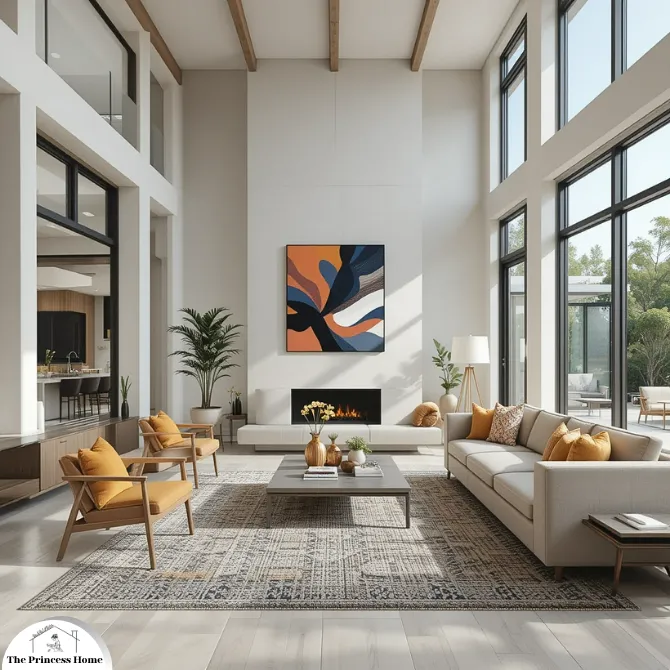
Open Spaces & Neutral Color Palette
Contemporary design values open floor plans that encourage flow and flexibility. Use fewer walls and barriers to create a sense of spaciousness and make the most of natural light. Large windows and glass doors can help bring the outdoors inside, contributing to the airy feel. The base of contemporary style often features neutral tones like white, beige, gray, and black, which create a clean and calming backdrop. To add energy and personality to the space, incorporate bold accent colors like deep blues, vibrant reds, or citrusy yellows through furniture, artwork, or accessories.

Minimalist Furniture & Natural Materials
Furniture pieces in contemporary design are typically simple and streamlined, with clean lines and smooth surfaces. Choose pieces with low profiles and geometric shapes to maintain a sleek, unembellished look. Opt for furniture made from materials like glass, steel, or concrete for a more modern, industrial touch. While contemporary design often incorporates man-made materials, it also brings in natural elements like wood, stone, and natural fibers to add warmth and texture to the space. Exposed wooden beams, stone countertops, or wooden flooring can provide balance against more industrial elements like metal or concrete.
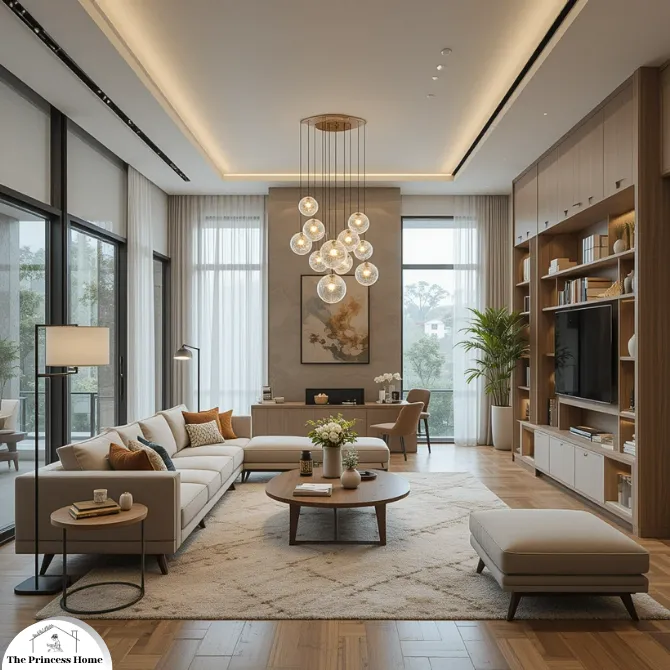
Comfort & Lighting as a Focal Point
Function is key in contemporary spaces. Furniture should be both aesthetically pleasing and practical, with comfortable seating and versatile storage solutions. Open shelving, multipurpose furniture, and hidden storage are popular in contemporary homes to maintain the clean, uncluttered look. Lighting in contemporary design goes beyond functionality; it becomes an integral part of the decor. Choose sleek, modern light fixtures like recessed lighting, track lighting, or minimalist floor lamps. Large, sculptural pendant lights or chandeliers can also act as artistic statement pieces.
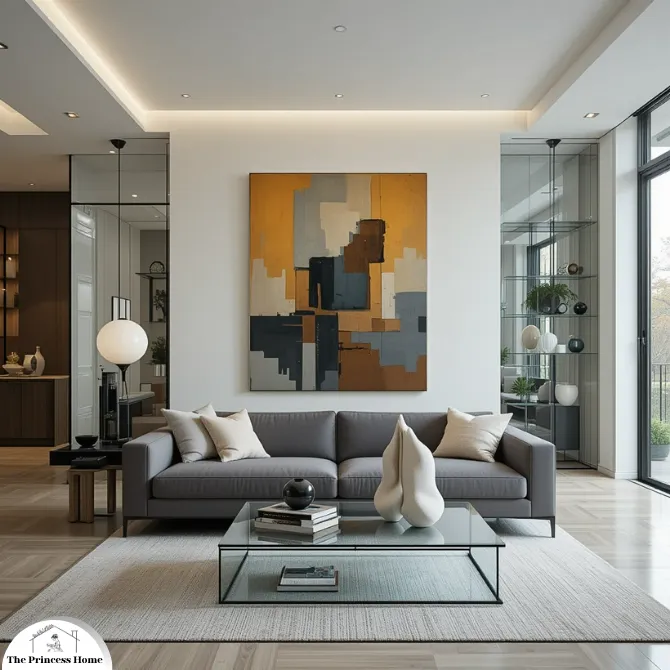
Abstract Art and Bold Décor
Contemporary interiors often feature modern, abstract artwork or sculptures that serve as focal points in the room. Keep décor to a minimum, but use select pieces like a bold, oversized painting, a geometric sculpture, or an interesting piece of ceramic art to make a statement. Glass elements play a big role in contemporary design. Use glass walls, doors, or even furniture like glass coffee tables to create a sense of openness. Glass is a great material for partitions that don’t disrupt sightlines or natural light in open spaces.
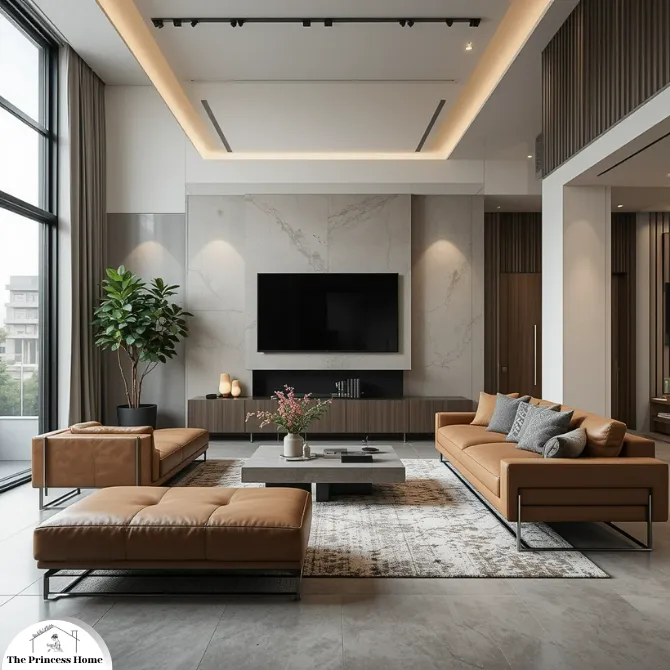
Mixing Materials & Smart Home
Contemporary design often blends a variety of materials, such as pairing soft textiles with hard surfaces like metal or glass. Contrast a leather sofa with a concrete coffee table, or combine a plush rug with sleek tile flooring for a dynamic mix of textures that adds interest without overwhelming the space. Given its modern and forward-thinking nature, contemporary style often incorporates smart home technologies. Think automated lighting, temperature control, and integrated sound systems that make life easier while complementing the clean and sleek design of the space.
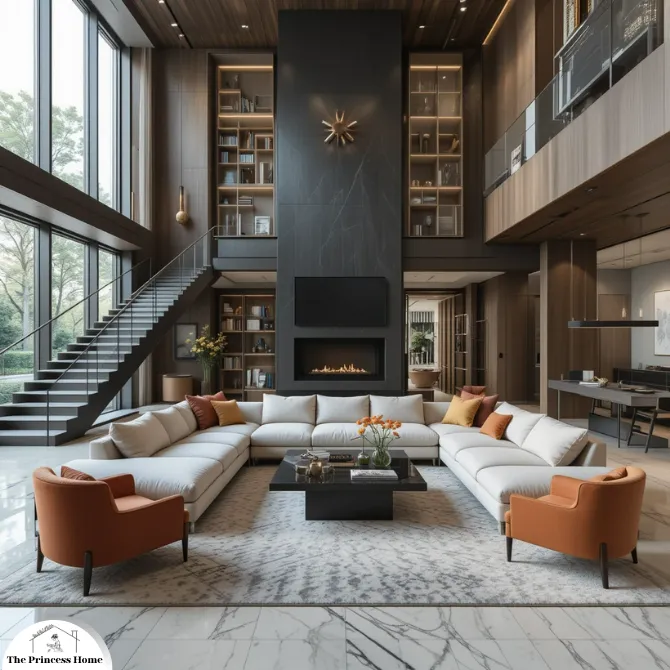
Architectural Details & Large Furniture
Elevate your space with custom architectural details, such as floating staircases, built-in bookshelves, or bespoke cabinetry. These features contribute to the overall modern aesthetic while providing added functionality. In keeping with the spacious, open feel, contemporary design often incorporates large-scale furniture pieces that are both striking and functional. A spacious sectional sofa, oversized coffee table, or bold accent chairs can define the room and provide ample seating for a variety of activities.

Sustainability & Eco-Friendly Design
As contemporary design is often about staying on the cutting edge, sustainability plays a role in its evolution. Use energy-efficient appliances, natural materials, and eco-friendly furnishings to create a design that is both stylish and environmentally responsible. Contemporary spaces generally feature smooth surfaces—think polished concrete floors, sleek granite countertops, and flat-panel cabinetry. Avoid overly ornate or heavily textured finishes, and instead choose surfaces that feel clean, fresh, and streamlined.
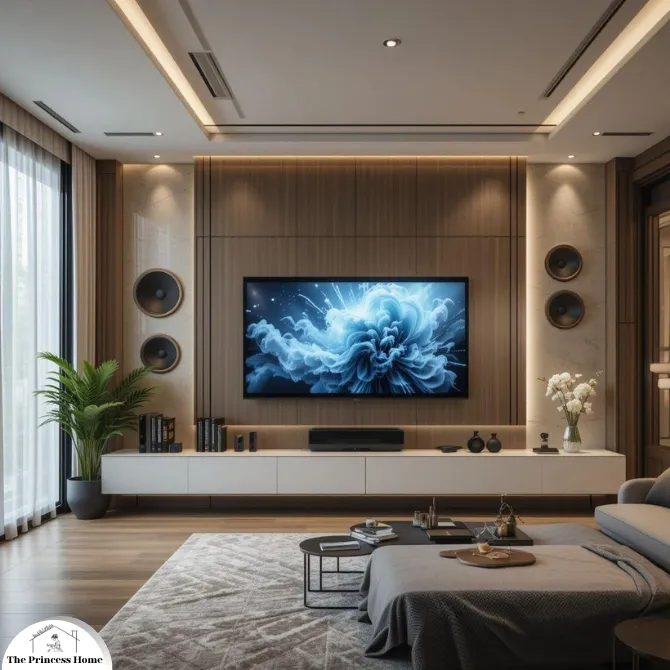
Integrated Technology:
Contemporary design often embraces technology in a seamless way. Build technology into the design by integrating speakers into walls, adding smart thermostats, or incorporating hidden wiring for televisions and devices, creating a space that’s both high-tech and chic.
By focusing on open spaces, sleek furniture, and a neutral base with vibrant accents, contemporary design delivers a fresh and ever-evolving style that offers both style and function for those who want to stay ahead of the design curve. This adaptable and modern approach works well in both urban and suburban settings and fits those who enjoy a sophisticated, forward-thinking environment.
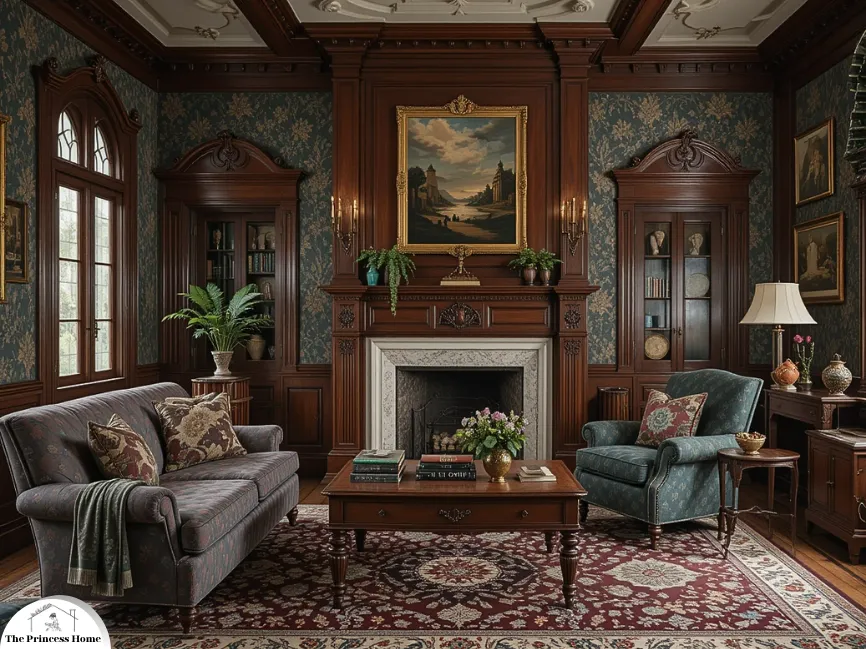
10. Traditional Style
Traditional design is rooted in classic European styles, offering a formal, elegant atmosphere with rich wood furniture, antique accents, and luxurious fabrics. The color palette often includes deep, rich tones like burgundy, navy, and forest green, with intricate patterns in textiles and wallpaper. furniture is often ornate and heavy, featuring intricate carvings and rich wood tones.
Traditional style works well in spaces that are meant to feel stately and refined, offering a sense of comfort through its familiarity and history. Traditional style creates a timeless and sophisticated ambiance, emphasizing elegance and rich history. Here are key elements that define this classic design:
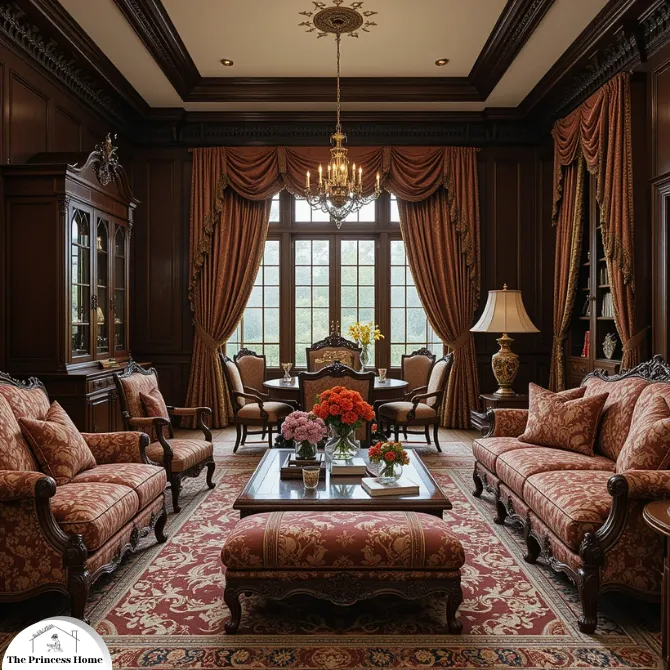
Wood Furniture & Elegant Fabrics:
Traditional style is known for its use of dark, polished wood, such as mahogany, cherry, or oak. Furniture pieces are often large and stately, with intricate carvings and ornate detailing. You’ll find beautifully crafted cabinets, armoires, dining tables, and chairs that add a sense of permanence and heritage to the space. Luxurious fabrics like velvet, silk, and damask are often used in traditional interiors. Upholstered furniture such as sofas, armchairs, and ottomans feature rich, patterned fabrics that complement the overall color scheme. Heavy drapes or curtains with intricate patterns often adorn the windows, creating a formal atmosphere.
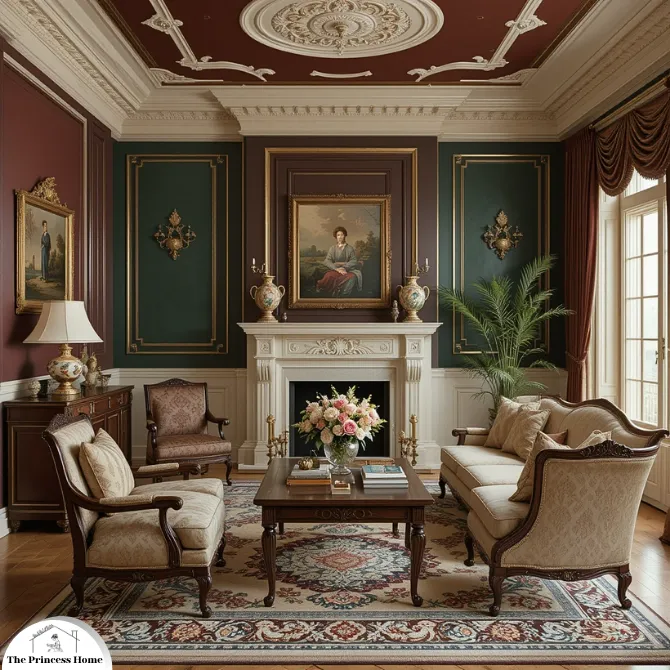
Classic Color & Ornate Details
Traditional spaces are typically decorated in rich, deep hues like burgundy, navy, forest green, and gold. These colors evoke a sense of warmth and comfort, while also conveying a sense of refinement. Neutral tones like cream, beige, and taupe are often used as complementary shades for walls and trim. Traditional design incorporates ornate details such as carved wood furniture, decorative crown molding, and intricate plasterwork on ceilings and walls. These elements add a sense of grandeur and craftsmanship to the space.
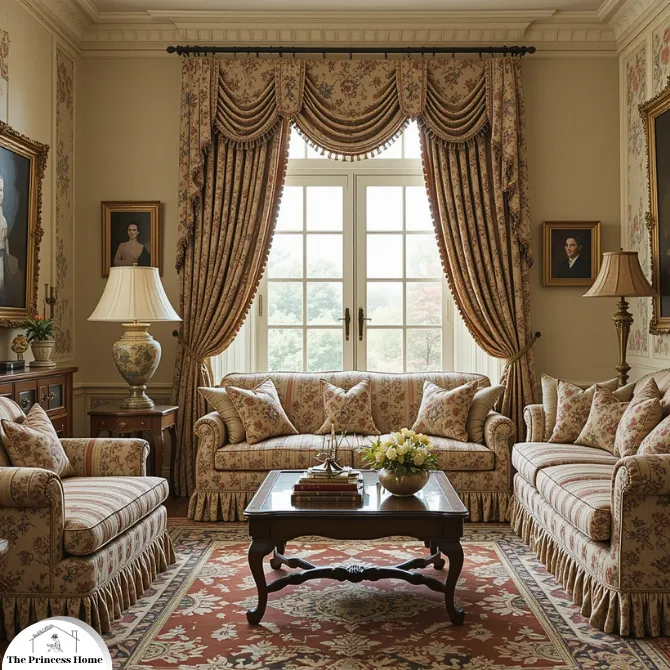
Patterned Textiles & Antiques
Fabrics with intricate patterns, such as floral, damask, and stripes, are often used for curtains, rugs, and throw pillows. These patterns add visual interest and are often layered to create a rich, luxurious look. The inclusion of antique furniture, artwork, and accessories is a hallmark of traditional style. These pieces, passed down through generations, contribute to the timeless quality of the space and add character and personal history to the décor.
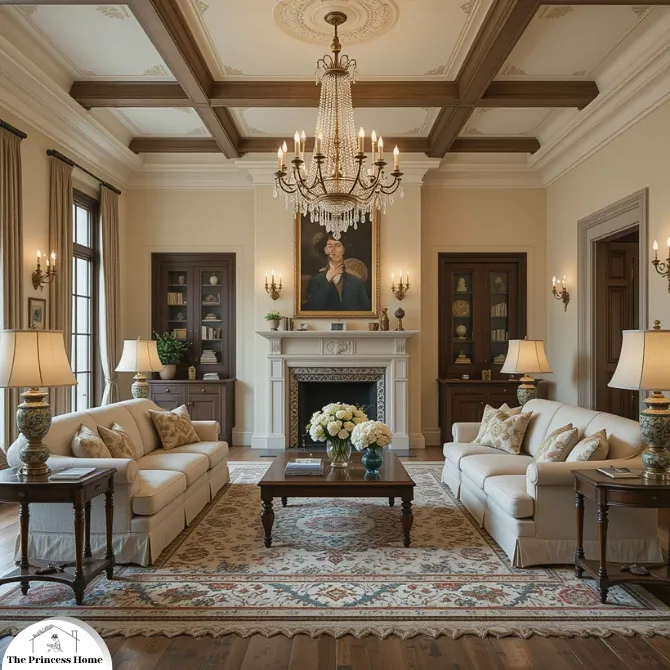
Formal Layout & Elegant Lighting
Traditional interiors often feature a formal layout, with furniture arranged symmetrically around focal points like a fireplace, large windows, or a central piece of artwork. The arrangement creates a sense of balance and harmony in the space. Traditional spaces frequently feature elegant chandeliers, sconces, or pendant lights with ornate detailing. Crystal or brass fixtures can add sophistication, while providing both ambient and task lighting throughout the room.
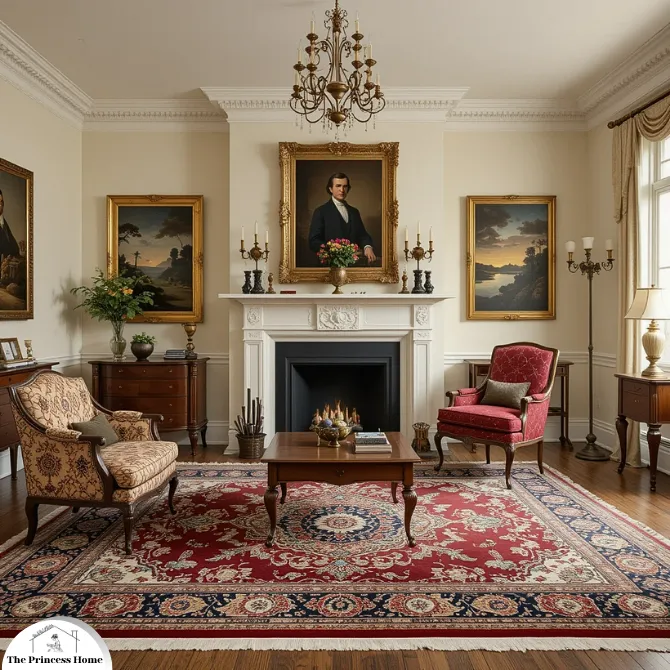
Fine Rugs &Classic Artwork
Persian or Oriental rugs are common in traditional homes, offering both comfort and visual appeal. These rugs often feature intricate patterns and rich colors that tie the room together and provide warmth to hardwood floors. Traditional design often includes classic paintings, portraits, or landscapes in gilded frames. These works of art contribute to the room’s refined atmosphere, complementing the stately and historical feel of the space.
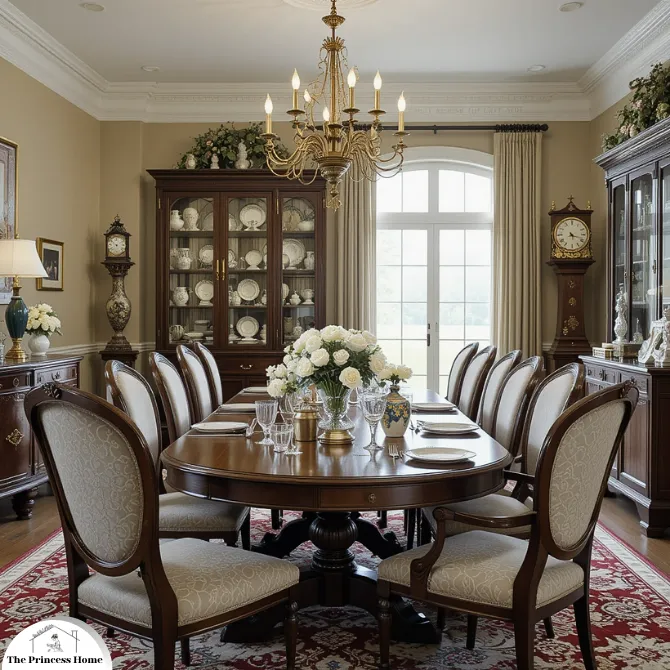
Antique Accessories & Dining Areas
Decorative accessories such as fine china, brass candelabras, porcelain figurines, and vintage clocks enhance the traditional look. These items are carefully selected to complement the room’s classic aesthetic and often serve as heirlooms or collectibles. The dining room in a traditional home is often a focal point, with a large wooden table surrounded by upholstered chairs. China cabinets or buffets display fine china, crystal, and silverware, adding to the formal, polished atmosphere.
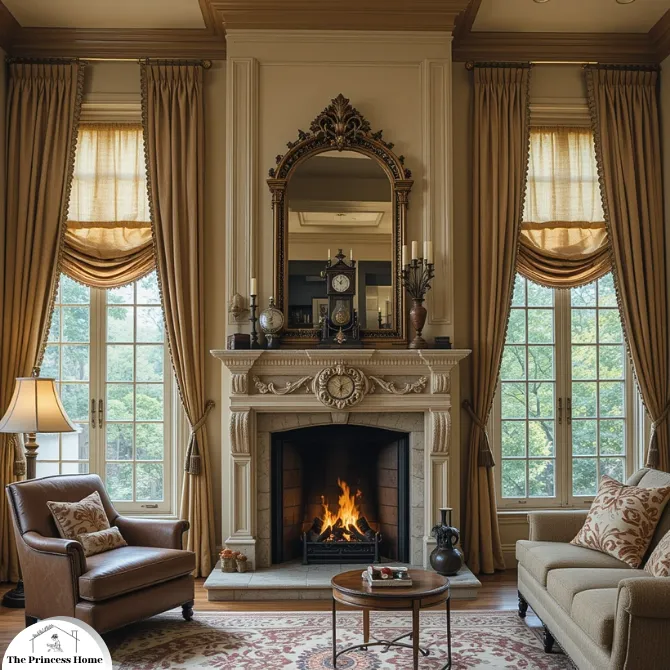
Window Treatments & Fireplace
Traditional homes typically feature elaborate window treatments, such as heavy drapes, valances, or roman shades in luxurious fabrics. These treatments help frame the windows and add a sense of richness to the space. Fireplaces in traditional style homes are often grand and serve as the focal point of a room. They may be made of stone or wood and feature detailed mantels with intricate carvings or antique clocks and mirrors above.
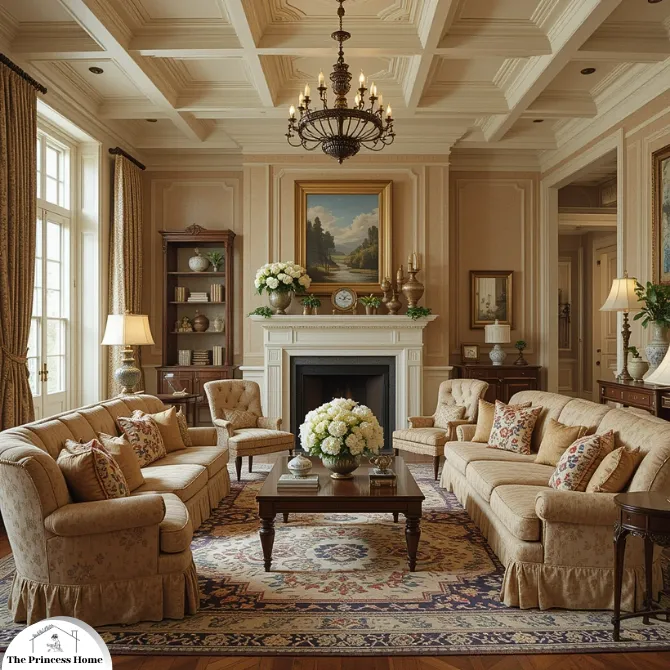
Comfort & Classic Architectural Features
Despite its formal appearance, traditional design is all about creating a comfortable, inviting atmosphere. Soft, plush fabrics and ample seating arrangements make the space feel cozy, while the rich colors and textures add a sense of timeless luxury. Traditional interiors often incorporate architectural elements like columns, wainscoting, and coffered ceilings. These features lend a stately, historical feel and contribute to the room’s overall grandeur.
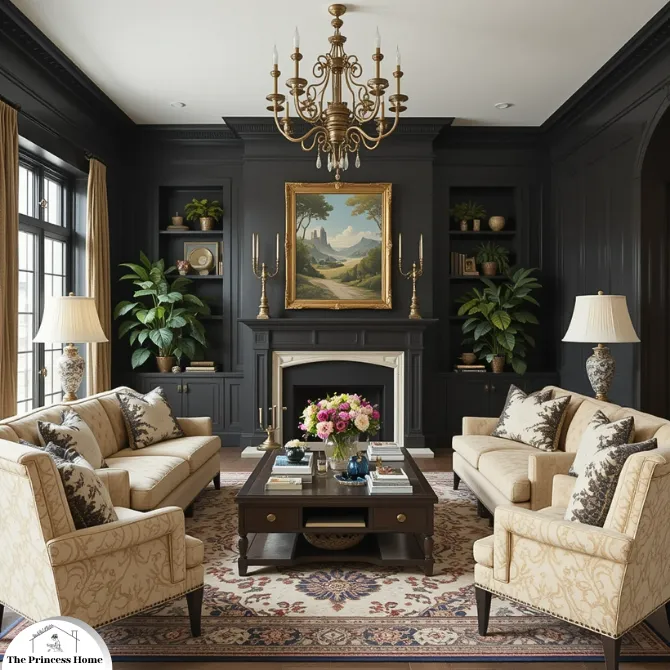
Balance and Symmetry:
Symmetry is a key principle in traditional design, from the arrangement of furniture to the placement of artwork or mirrors. This balance creates a sense of order and harmony, enhancing the formal yet inviting atmosphere of the room.
Traditional style is perfect for those who appreciate timeless elegance, historical richness, and a refined, comforting space. With its emphasis on classic design elements and luxurious materials, this style creates a warm, stately environment that is both inviting and sophisticated.
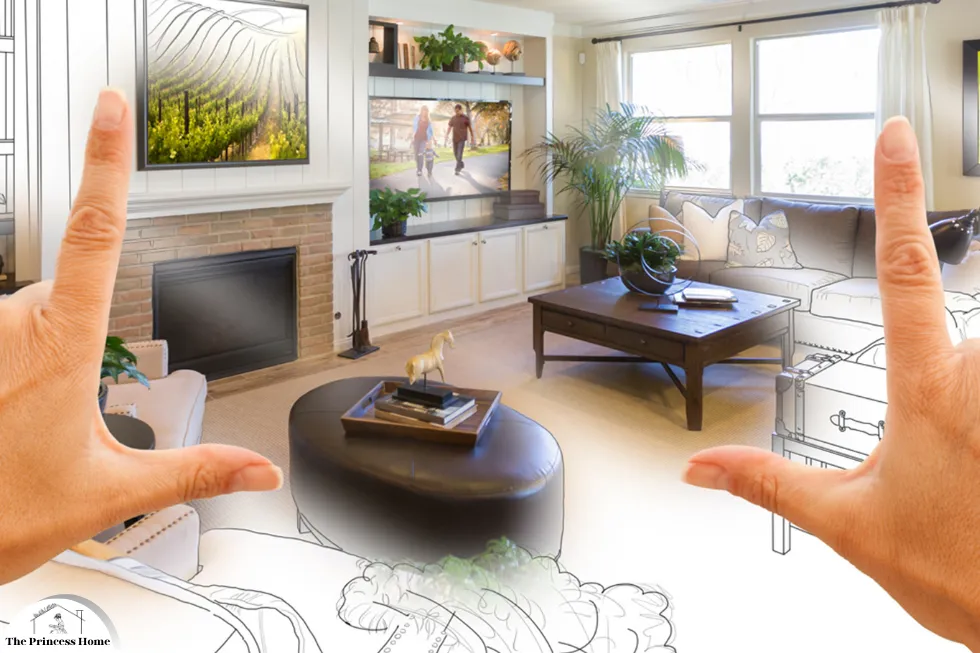
21.*Create Design Boards:
Visualize your ideas and inspirations by creating design boards for each room. Use platforms or apps that allow you to gather images, colors, and textures in one place. This helps you assess how different elements will work together before implementing them in your home. Creating design boards is an excellent way to visualize your ideas and inspirations for each room in your home. Here’s how you can create design boards using platforms or apps:
1.Choose a Platform or App
Select a platform or app that allows you to gather images, colors, and textures in one place. Popular options include Pinterest, Canva, Adobe Spark, and Houzz. Choose a platform that best suits your preferences and allows you to easily organize and edit your design boards.
2.Gather Inspiration
Start by gathering inspiration from various sources such as design blogs, magazines, social media, and online galleries. Save images, colors, patterns, and textures that inspire you and reflect the look and feel you want to achieve in each room.
3.Organize Your Ideas
Create separate design boards for each room in your home to keep your ideas organized and focused. Label each board with the name of the room and add categories or sections to group similar elements together, such as furniture, decor, color schemes, and textiles.
4.Add Images &Textures
Use the platform or app to add images of furniture, decor items, paint colors, fabrics, and textures to your design boards. Arrange the images in a visually pleasing layout and experiment with different combinations to see how various elements will work together in your space.
5.Review &Refine
Take time to review your design boards and assess how different elements will work together in each room. Make adjustments and refinements as needed to ensure that your design vision aligns with your preferences and goals for each space.
By creating design boards, you can effectively visualize your ideas and inspirations, experiment with different design elements, and plan your home decor projects with confidence and clarity. Design boards also serve as valuable reference tools throughout the design process, helping you stay organized and focused as you bring your vision to life.
Conclusion:
Your home is a reflection of your personality, and the design style you choose should feel natural and true to your preferences. Whether you gravitate toward the sleek sophistication of modern design, the cozy warmth of rustic style, or the creative freedom of Bohemian decor, there’s a design style for everyone. Take your time exploring different options, and don’t be afraid to mix elements from various styles to create a home that’s uniquely yours. The most important thing is that your space feels comfortable, inviting, and a true reflection of your taste.
Here are some frequently asked questions related to the article :
Q1: How do I find the right design style for my home?
A: Start by reflecting on your personal preferences, lifestyle, and cultural influences. Look for inspiration in design magazines, online platforms, and visit showrooms to get a feel for different styles. Create mood boards to visualize your ideas.
Q2: Can I mix different design styles in one home?
A: Yes, absolutely! Many homes feature a blend of styles, creating a unique and eclectic look. The key is to find a common thread or color palette that ties everything together, ensuring a harmonious overall feel.
Q3: What’s the importance of lighting in home design?
A: Lighting can significantly impact the mood of a space. Experiment with different light fixtures to create ambiance, and consider natural light sources. Adequate lighting enhances both functionality and aesthetics in your home.
Q4: How can I make my home more sustainable in terms of design?
A: Choose eco-friendly materials, prioritize energy-efficient appliances, and consider second-hand or repurposed furniture. Sustainability can be integrated into every aspect of your home, from construction materials to daily practices.
Q5: How do I incorporate personal touches without overwhelming the space?
A: Select a few meaningful items, such as family photographs, souvenirs, or handmade decor, and strategically place them throughout your home. Less can often be more, allowing each piece to stand out.
Q6: What if I’m on a budget?
A: Prioritize your spending on key items like furniture and paint. Explore budget-friendly options for accessories and consider DIY projects. Thrift stores and online marketplaces can also be treasure troves for affordable, unique pieces.
Q7: How do I ensure a cohesive color scheme throughout my home?
A: Choose a base color or theme and carry it through different rooms. This creates a sense of continuity. Experiment with shades and tones within the chosen palette to add variety while maintaining cohesion.
Q8: Can technology and home decor coexist?
A: Absolutely. Consider integrating smart home solutions that align with your design aesthetic. Conceal wires and devices where possible, ensuring technology enhances the functionality of your home without disrupting its visual appeal.
Q9: How often should I update my home decor?
A: Home decor is a personal choice, but it’s good to refresh your space periodically. Consider seasonal updates for a subtle change, and reassess your decor as your tastes evolve or significant life changes occur.
Q10: Should I consult a professional designer?
A: If you find the process overwhelming or want expert advice, consulting with a professional interior designer is a great idea. They can provide insights, help define your style, and guide you in creating a cohesive and well-designed home.

